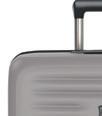







































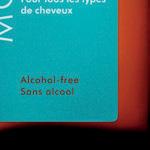














































































































































As we convene in Singapore for the TFWA Asia Pacific Exhibition & Conference this year, we stand at the cusp of significant transformations in the travel retail landscape. Long has it been stated that GTR is behind the times, but that is rapidly changing, and nowhere is that clearer than in this region.
The strategic use of technology in marketing and customer interaction is leading the charge, from the tobacco category, where detailed analysis by m1nd-set reveals a niche yet profitable market segment, to the evolution of e-commerce platforms like Jessica’s Secret, which utilize AI and data analytics, revolutionizing the pre-travel shopping experience. These platforms not only predict but actively shape consumer preferences, offering a glimpse into the future.
The re-emergence of Chinese tourists marks a defining moment for travel retail, signaling a shift toward preferences for sustainable luxury, advanced digital features and personalized experiences. Insights into consumer behaviors suggest a vigorous return with an emphasis on high-quality, culturally rich shopping experiences that resonate deeply with a new generation of travelers.
Ever at the forefront, design and marketing are busy envisioning a future reality that will mean success for the industry. Portland Design’s visionary approach is redefining airport spaces as vibrant community-centric areas, turning them into dynamic brands that enhance traveler engagement, while ALIVE’s Aviator initiative simplifies the complexities of airport marketing, ensuring that brands can seamlessly interact with the diverse APAC market.
Operators across the region, from Delhi Duty Free to Lotte Duty Free, are pioneering changes that showcase the effectiveness of digital strategies and experiential retailing. These industry leaders illustrate how integrating online and physical engagements can create a seamless consumer journey, enhancing customer satisfaction and loyalty.
Meanwhile, brands in confectionery and spirits are using regional and festive nuances to enhance brand relevance and drive sales, successfully leveraging these strategies with exclusive launches and culturally tailored products that attract affluent travelers seeking unique and luxurious experiences.
As we explore these transformative themes, our magazine is committed to bringing you the latest and most comprehensive insights. From the resurgence of markets like India and China to innovative digital transformations across the region, TFWA Asia Pacific 2024 is not just a meeting point but a launchpad for the next era of travel retail.
We invite you to enjoy this issue, immerse yourself in the wealth of information, and join us in navigating the exciting prospects to come.

Kindest regards,
 HIBAH NOOR Editor-in-Chief hibah@gtrmag.com
HIBAH NOOR Editor-in-Chief hibah@gtrmag.com
MAY 2024 ·
Global Travel Retail Magazine (ISSN 0962-0699) is published seven times a year by Paramount Publishing Company Inc. The views expressed in this magazine do not necessarily reflect the views and opinions of the publisher or the editor May 2024, Vol 36. No. 3. Printed in Canada. All rights reserved. Nothing may be reprinted in whole or in part without written permission from the publisher. Paramount Publishing Company Inc.
GLOBAL TRAVEL RETAIL MAGAZINE Tel: 1 905 821 3344 www.gtrmag.com
PUBLISHER Aijaz Khan aijaz@globalmarketingcom.ca
EDITORIAL DEPARTMENT
EDITOR-IN-CHIEF Hibah Noor hibah@gtrmag.com
DEPUTY EDITOR Laura Shirk laura@gtrmag.com
SENIOR WRITER Alison Farrington alison@gtrmag.com
SENIOR EDITOR Wendy Morley wendy@gtrmag.com
ART DIRECTOR Jessica Hearn jessica@globalmarketingcom.ca
CIRCULATION & SUBSCRIPTION MANAGER accounts@globalmarketingcom.ca



12 Retail horizon
The forecast for Asia’s travel retail is robust growth through 2029, driven by a burgeoning middle class, emerging trends in innovative shopping technologies and sustainable practices
22 New era
Lotte Duty Free is redefining the shopping landscape with its innovative omnichannel approach, ensuring a fluid and cohesive experience across all stages of the consumer journey
34 Surfing the digital wave
With a keen understanding of consumer trends, Jessica’s Secret uses cutting-edge technology to craft a seamless shopping experience for travelers, prioritizing intuitive design and strategic partnerships
38 Powerful brands, community spaces
Portland Design’s Ibrahim Ibrahim calls for airports to embrace their potential as dynamic place brands, creating enriched environments that foster community and deepen brand engagement
18 A pillar of possibilities
Capitalizing on a surge in international travel to redefine retail experiences at the crossroads of culture and commerce, Delhi Duty Free is implementing digital solutions to enhance customer engagement and streamline shopping
28 Domestic promise
Gebr. Heinemann is set on expansion in the Australian domestic market, as the travel retailer reports strong trading after recent store launches at Sydney and Gold Coast duty paid airport locations
32 Ready for takeoff
As Chinese outbound travel gains momentum, a new generation of tourists is demanding personalized, sustainable and culturally rich experiences, presenting opportunities for savvy travel retailers to thrive
44 The big 5
Committed to delivering world-class visitor experiences, Jewel Changi Airport is celebrating its fifth anniversary with a year-long series of special events and retail offers under the theme “What A Feelin5”
46 Connecting the dots
Based on input from aviation industry experts, Global Travel Retail Magazine reports on air connectivity in Asia Pacific, domestic vs. international growth in China and the potential of the Southeast Asian market within air travel
50 Effective pain relief
Sharing insights on bridging the physical and digital divide, Managing Director Charlotte Birley dishes on the transformative impact of Aviator and other initiatives at experiential marketing agency ALIVE
54 Adversaries to allies
Travel retail fails when popular items become islands; in this guest column, One Red Kite’s Ken Brocklebank suggests a new merchandising concept that can help lead to success



58 At your service
A look at Elizabeth Arden’s holistic approach to beauty and travel reveals more about its “Travel with Arden” campaign, travel pitstop concept at Changi Airport and skincare hacks for those on the move
60 A healthy glow
In this Skincare Report, experts at Blue Chip Group, Shiseido Travel Retail and Nuxe Travel Retail discuss skinimalism, multi-functional products and current category trends
64 C-Beauty rising
Premiumization in skincare is not going anywhere as brands continue to trade up, especially in China; while Asia Pacific is on the agenda for many beauty companies’ expansion plans, Global Travel Retail Magazine asks is C-Beauty a rising threat?
68 A brush of fresh air
Solidifying its footprint in Asia, Moroccanoil’s Airy Moisture is expected to become a major pillar of the brand in the region; plus, talk about travel retail sets, APAC openings and more
70 Eastern indulgence
A look at Asia’s duty free confectionery landscape with some of the region’s top retailers as they commandeer shifting trends, digital innovations and pet-friendly initiatives
74 Tasteful tradition
Global confectionery companies Mars, Mondelēz and Nestlé are leveraging regional festivities and cultural nuances to enhance brand relevance and drive sales in the Asia Pacific market
76 Preparing the next generation
With a focus on comprehensive messaging, Victorinox’s “Made to be Prepared” campaign marks a new chapter for the brand; a larger booth space at this year’s show will help showcase its two core categories in travel retail: travel gear and watches
78 Distilled elegance
Global spirits companies are responding to Asia Pacific’s growing demand for premium drinks with exclusive launches and engaging marketing strategies, transforming the channel into a hotspot for luxury spirit consumption
80 Spirited tradition
Fraternity Spirits offers a unique journey through Mexican heritage; anchored by Hacienda Corralejo, it pioneers in sustainability and custom aging, redefining the premium spirits landscape in travel retail
82 Investment and expansion
Jägermeister sales surged in 2023, driving global growth amid challenges; reporting an 8.1% increase in sales, it marked the second most successful fiscal year in the company’s history
84 Malt master
Kavalan’s new Master’s Select Reserve malt whiskies embody the essence of the distillery, which has been leading the art of single malt whisky in Taiwan since 2005
86 Purchasing potential
m1nd-set data from 2023 provides a clear indicator of the tobacco market in Asia Pacific; strong purchasing trends highlight an opportunity to capitalize on a niche but profitable segment

We’re making the journey as rewarding as the destination; bringing together Dufry’s retail and Autogrill’s F&B expertise to revolutionize the travel experience worldwide.
Low-cost carriers such as Air Asia are helping to boost travel throughout Asia, leading to increased travel retail sales

The forecast for Asia’s travel retail is robust growth through 2029, driven by a burgeoning middle class, emerging trends in innovative shopping technologies and sustainable practices
by WENDY MORLEYThe Asia travel retail market is projected to reach US$98.11 billion by 2029, up from US$63.15 billion in 2024, marking a compound annual growth rate (CAGR) of 9.21% over the fiveyear period. This growth trajectory is influenced by multiple factors including rising middle class affluence, increased digital integration and evolving consumer behaviors toward sustainable and experience-based shopping.
The revival of international travel and regional tourism has played a critical role in propelling the demand for duty free shopping, with key markets
China, Japan, South Korea and India spearheading this growth.
The expansion of new air routes and the entry of low-cost carriers (LCC) are key drivers in the growth of the Asia Pacific duty free and travel retail market. Increased consumption and higher purchasing power in China and India are likely to positively influence this market. Additionally, in this region, a preference for unique and value-added products is encouraging more travel, which is anticipated to boost demand within the duty free industry.

Trip.com CEO Jane Sun reminds us that Asia is poised to account for half of the global GDP growth, thanks in part to its thriving tourism sector

navigate various economic pressures and changing consumer demographics to maintain momentum
Sunil Tuli, President of APTRA and King Power Group (Hong Kong) Group CEO, says China remains a critical player in the region’s economic landscape, particularly in the travel retail channel, but warns the market must

The adoption of modern lifestyles and affordable travel package offerings by companies like MakeMyTrip, Cleartrip, and GoIbibo are expected to contribute to the expansion of the global duty free and travel retail market. Meanwhile, the swift expansion of social media and digital technologies will present attractive and innovative opportunities for retailers and brands in the Asia Pacific market over the forecast period.
Asia’s burgeoning middle class continues to be a pivotal element in the expansion of travel retail. Increased disposable incomes and a greater propensity for discretionary spending are fueling purchases of luxury goods, cosmetics and technology-driven products. The Asian market’s responsiveness to innovation is particularly noticeable in categories such as wearable technology, with airports emerging as critical hubs for consumer engagement with new tech.
In 2024, the travel retail market in Asia is showing promising signs of robust growth. Jane Sun, CEO of Trip.com, recently highlighted the remarkable uptick in travel bookings to Asia, with destinations like Thailand, Japan and South Korea becoming increasingly popular due to their premium wellness and eco-tourism offerings. This surge is backed by a broader economic optimism in the region, as Asian countries continue to foster environments that attract significant international attention and investment.
Conversely, the situation in China has shown the complexities of rapid economic transitions. Sunil Tuli, President of APTRA and King Power Group (Hong Kong) Group CEO, recently pointed out that despite a general slowdown, China remains a critical player in the region’s economic landscape, particularly in the travel retail channel. Last year saw a hopeful resurgence in
travel following China’s easing of travel restrictions, although the recovery has been slower than anticipated.
Airports, no longer just transit points, are becoming vibrant retail hubs where culture, commerce and technology converge. Innovative practices such as virtual reality fittings and AI-driven personalized shopping are enhancing customer experiences, making shopping seamless and more engaging.
Increasingly, travel retail is more about creating an experience than making a transaction. Innovations such as pre-travel digital shopping platforms, exemplified by partnerships like that of Lagardère Travel Retail with Inflyter, are reshaping how consumers engage with travel retail by allowing them to browse and purchase goods before they reach the airport.
The integration of technology in APAC travel retail continues to revo-
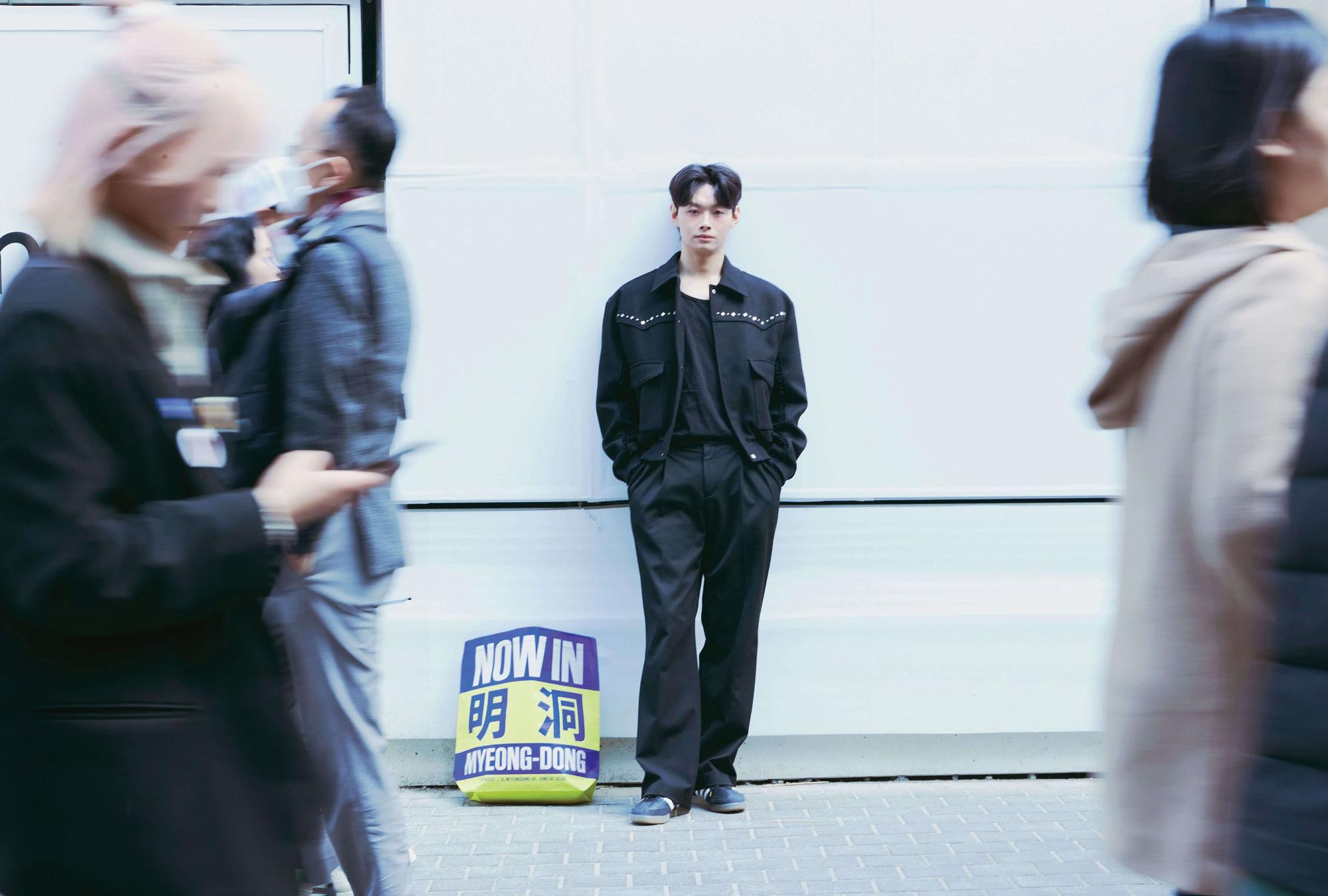


lutionize the industry, pushing beyond traditional boundaries. Advanced implementations include augmented reality (AR) fitting rooms and interactive digital kiosks; Shiseido’s advanced diagnostic tools uses AI technology that provide personalized recommendations. AI-driven data analytics are being employed by retailers like Lotte Duty Free to predict purchasing behavior and optimize inventory. Additionally, the surge in mobile commerce and the implementation of seamless omnichannel services are enabling consumers to shop anytime, anywhere, without the constraints of travel schedules.
The Chinese traveler remains a crucial customer throughout the region, and the preferences and behaviors of Chinese travelers continue to evolve, showcasing a distinct divergence based on chosen destinations, according to recent findings by travel retail research company m1nd-set. This shift, markedly influenced by the aftermath of the global pandemic, highlights a nuanced transition in both travel motivations and shopping habits among this demographic.
Chinese tourists are making a notable pivot toward destinations that are not just vacation spots but also serve
as cultural and experiential hubs. This trend reflects a broader desire among travelers to engage more deeply with the destinations they visit. Instead of traditional sightseeing or shopping excursions, many are now seeking immersive experiences that offer a sense of connection and understanding of the local culture.
The Asian consumer market is showing a marked preference for sustainable and ethically sourced products. Sustainability is becoming a cornerstone of brand and retail strategies across the region. Consumers are increasingly aware of environmental issues and seek brands that prioritize sustainable practices. This shift is influencing stock choices at duty free outlets, where eco-friendly products and packaging are becoming more prevalent.
Another noticeable trend globally, and APAC is no exception, is toward enhancing the passenger experience by providing a strong local flavor in retail offerings. This approach both caters to the cultural curiosity of international travelers and offers familiar favorites to local populations.
Lotte Duty Free’s rebranding of its downtown shopping store in Seoul to “Now in Myeong-dong” highlights local
cultural elements. The store’s design incorporates multilingual signage and local architectural cues to attract both international visitors and Korean nationals. In Australia, Heinemann Asia Pacific collaborates with local brands to offer passengers at Sydney Airport a unique selection of Australian products, thus enhancing the travel retail experience by offering a taste of the local culture.
Such initiatives across Asia Pacific travel retail demonstrate a conscious move towards creating a more engaging and culturally rich shopping environment, which is appreciated by international tourists and local consumers alike, providing a sense of place, boosting sales and promoting local culture and products on a global platform.
The next five years are critical for stakeholders in Asia’s travel retail industry. As Jane Sun optimistically notes, Asia is poised to account for half of the global GDP growth, thanks in part to its thriving tourism sector. However, as Sunil Tuli has warned, the market must navigate various economic pressures and changing consumer demographics to maintain momentum.
The Asia travel retail market is at a pivotal juncture. With robust growth projections and a rapidly changing retail environment, stakeholders need to leverage technological advancements and align with evolving consumer expectations to harness the potential of this vibrant sector. The strategies implemented today will pave the way for future successes and set a benchmark for global travel retail markets.
To capitalize on these evolving trends, airports and other travel hubs are investing heavily in enhancing the retail experience. This includes expanding luxury and duty free goods offerings as well as incorporating local products that reflect the cultural heritage of each region. Such strategic enhancements are crucial for sustaining growth and remaining competitive in the dynamic Asia travel retail market.

Delhi Duty Free’s approach is deeply rooted in understanding and responding to the evolving preferences of a diverse clientele, utilizing data analytics to tailor their service offerings
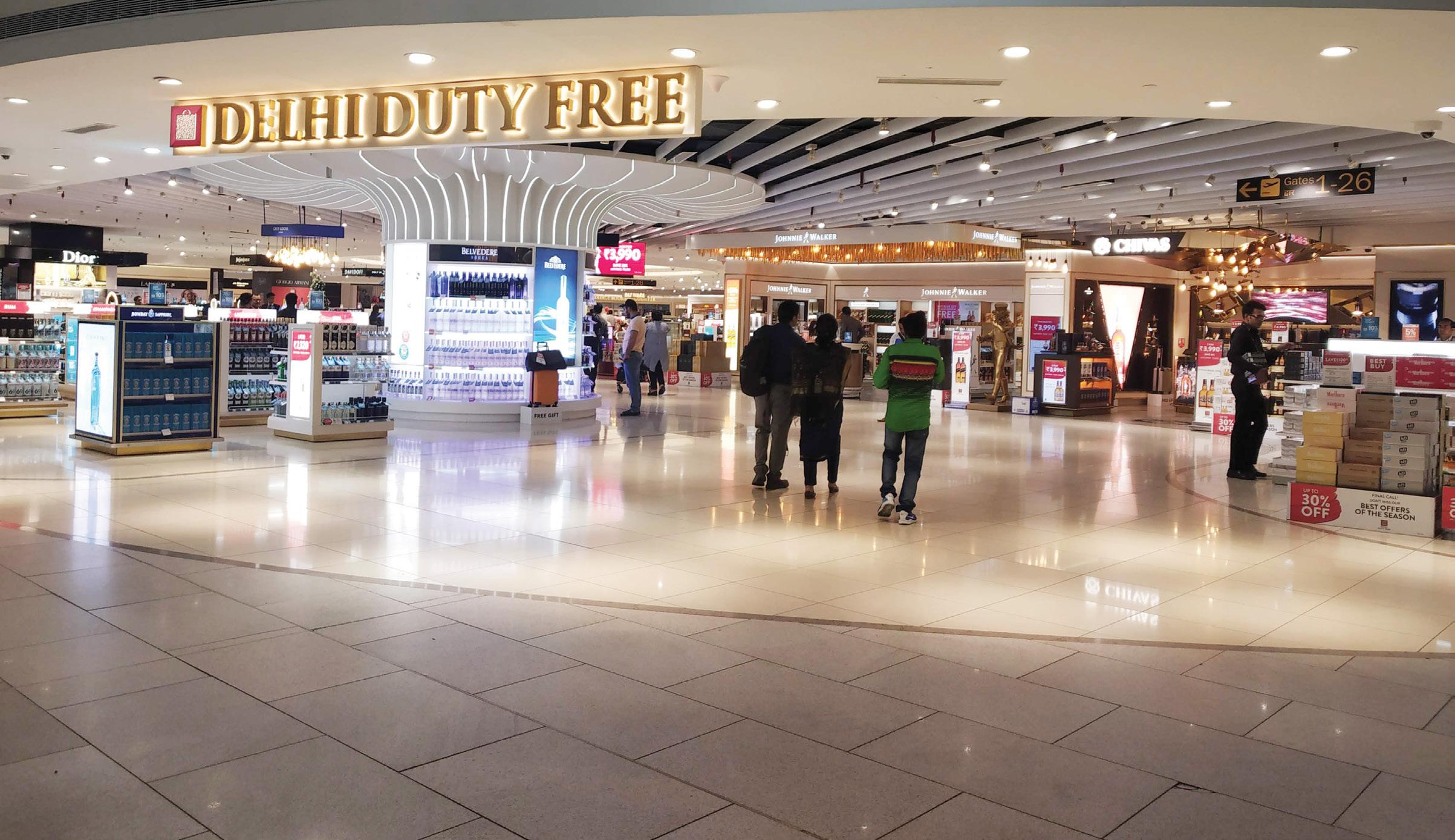
Capitalizing on a surge in international travel to redefine retail experiences at the crossroads of culture and commerce, Delhi Duty Free implements digital solutions to enhance customer engagement and streamline shoppingby HIBAH NOOR
India has been top of mind for the travel retail industry, as demonstrated by APTRA’s recent India 2024 Conference. And Delhi Duty Free has firmly positioned itself as a leader in this burgeoning market, notably acting as the Platinum Host Partner for this event, demonstrating a steadfast commitment to excellence in service and innovation in travel retail.
Delhi Duty Free (DDF) has been proactive in capitalizing on the post-pandemic recovery of global travel, taking advantage of the surge in international travel from India. The company has implemented a series of strategic initiatives aimed at optimizing customer engagement and enhancing the shopping experience. “India spearheaded the global travel retail recovery with increased passenger numbers
traveling abroad, resulting in stronger business growth,” Ashish Chopra, CEO, DDF stated. “Initiatives included enriching the product range, refining store layouts to enhance customer flow, enhancing staff training, and driving premiumization to elevate the overall shopping experience.”
Since the stores opened in 2017, the adoption of digital technologies has been paramount for the travel retailer. “Since the installation of digital enhancements such as video walls and digital screens in our stores, we have seen enhanced customer engagement,” says Chopra. “These technologies have allowed us to deliver targeted promotions, showcase product features and create immersive shopping experiences resulting in increased customer satisfaction and higher sales.” This emphasize on digital transformation is complemented by the expansion

of their online pre-order service, which integrates online and in-store shopping to provide a seamless, personalized customer experience.
DDF has proven itself a premier venue for new product launches and exclusive brand collaborations, according to Chopra, “DDF is increasingly sought out as a partner to showcase new products and exclusive launches,” he says. “Our collaborations with brands like Royal Salute for the 25-Year-Old Delhi Edition



and multi-fragrance campaigns like ‘Fly With Me’ demonstrate our commitment to offering unique and innovative products that appeal to our diverse customer base.”
The integration of local Indian products such as Single Malt Longitude 77 into the retail mix plays a crucial role in the company strategy, Chopra notes, “These products not only showcase the rich cultural heritage of India but also cater to the preferences of local and international travelers looking
for authentic experiences. We ensure a strong sense of place by curating a diverse selection of products that reflect the spirit of India.”
The rise of the Indian spirits market has favorably impacted DDF’s liquor sales. As consumer preferences shift towards premium and exclusive spirits, DDF continues to adapt its offer. The growth is mirrored in the fragrance and cosmetics categories, which have seen significant increases due to new brands, premiumization and promotional activi-
ties. “Indeed, our fragrance and cosmetics sales have experienced significant growth recently,” says Chopra. “This can be attributed to various factors such as the introduction of new brands, exclusive launches, and promotional campaigns aimed at enhancing the shopping experience.”
DDF’s approach is deeply rooted in understanding and responding to the evolving preferences of a diverse



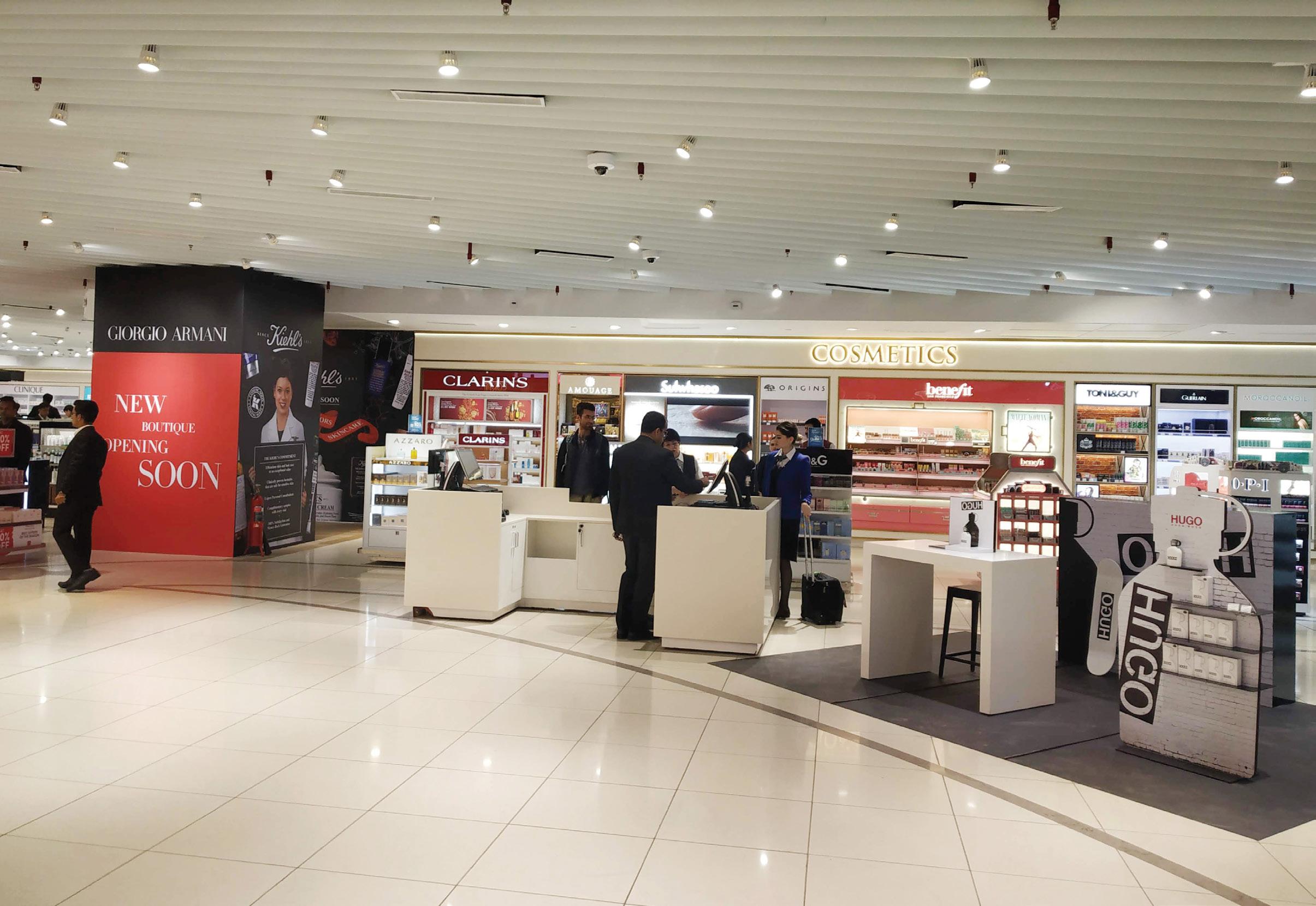
clientele, utilizing data analytics to tailor their service offerings. “Data analytics and customer feedback play a crucial role in our continuous improvement efforts at DDF. This data-driven approach enables us to deliver personalized experiences and enhance customer satisfaction,” Chopra says.
The retailer is committed to continuously addressing the ever-changing tastes and preferences of international travelers, says Chopra. “DDF regularly updates its product selection and store layout,” he states. “We conduct market
research, monitor industry trends, and collaborate with brand partners to ensure that our offerings align with current consumer preferences. Additionally, we regularly refresh store layouts to create inviting and immersive shopping environments that resonate with our diverse customer base.”
Looking forward, Chopra is optimistic about the growth of travel retail in India, driven by economic factors and an expanding airline network. “Our out-
look for the travel retail sector in India over the next few years is optimistic. We anticipate continued growth in international travel,” he remarks, indicating his readiness to meet future market demands with continued innovation and customer-centricity.
As Delhi Duty Free continues to evolve and adapt, it aims to maintain its role as a pivotal player in shaping the future of the Indian travel retail industry, ensuring it remains at the forefront of delivering exceptional experiences to travelers worldwide.



 Delhi Duty Free is committed to continuously addressing the ever-changing tastes and preferences of international travelers
Delhi Duty Free is committed to continuously addressing the ever-changing tastes and preferences of international travelers
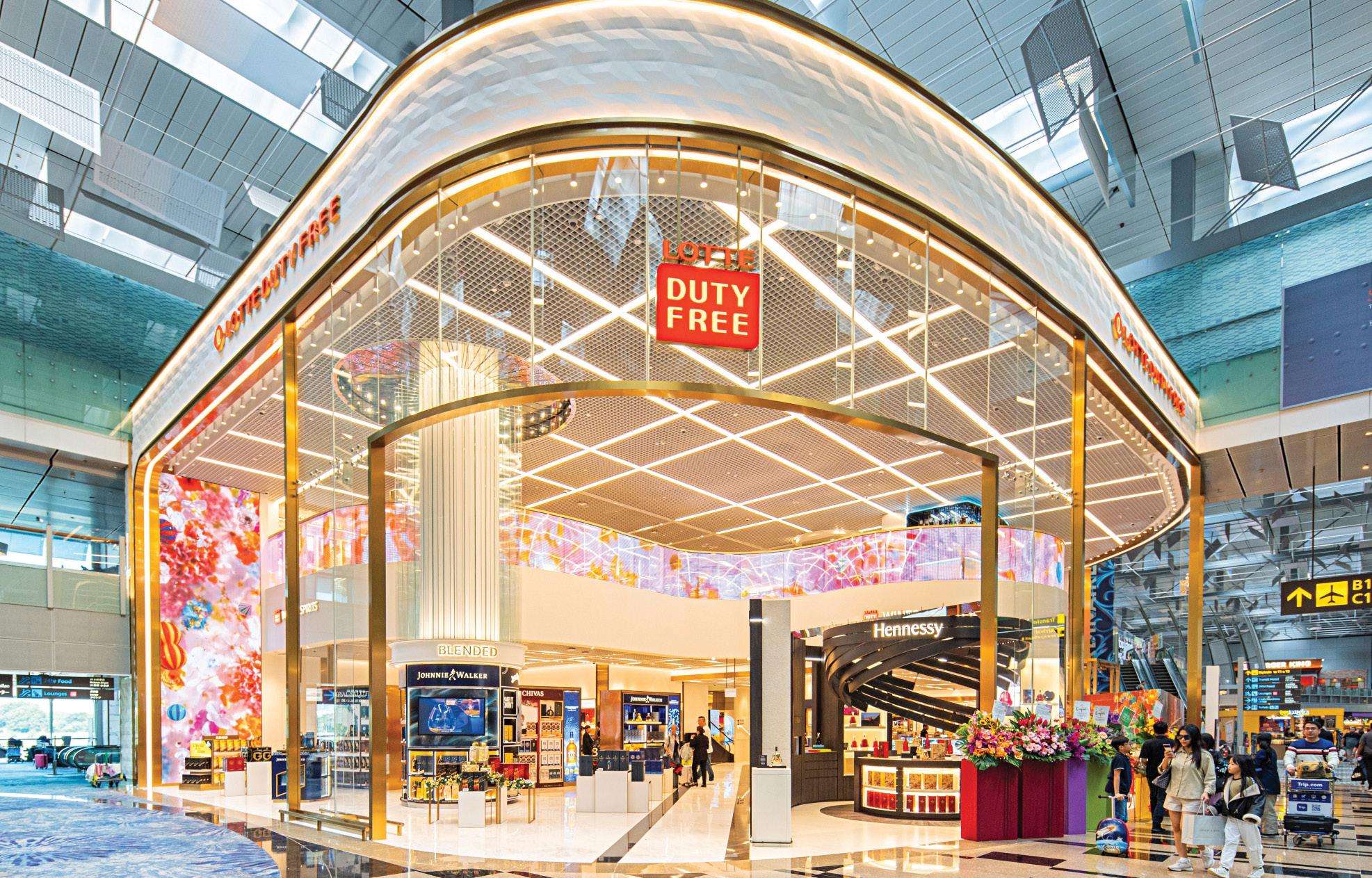
Lotte Duty Free is redefining the shopping landscape with its innovative omnichannel approach, ensuring a fluid and cohesive experience from online exploration to in-store interaction, covering all phases from entertainment to engagement to purchase and beyond
by HIBAH NOORAt the heart of Lotte Duty Free’s strategy lies a keen understanding of the consumer landscape. The company’s innovative approach is about more than simply facilitating transactions; rather, it’s about creating memorable experiences that resonate well beyond the point of sale.
Events such as all-night parties during Chuseok, family concerts and fan meetings are not just sidelines to the retail experience, but central to it. These gatherings are meticulously designed to offer customers a blend of entertainment and shopping, a formula that has proven successful in attracting a diverse clientele. The allure of such events, especially among foreign visitors, is a testament to Lotte Duty Free’s
ability to tap into the global Korean wave, leveraging it to not only enhance the appeal of their offerings but to also make significant inroads in terms of sales and customer loyalty.
Lotte Duty Free recently unveiled its “Hit a Homerun” spring campaign. As part of the campaign, the retailer teamed up with lifestyle brand New Era to present an exclusive pop-up activation at its Myeong-dong main store.
Inspired by the MLB (Major League Baseball) World Tour Seoul Series 2024, the March pop-up showcased the Seoul Series collection featuring baseball caps worn by MLB players, as well as T-shirts and hoodies. The campaign also included a prize giveaway and several
Duty Free operates 14 stores in six overseas countries

Daehyun Ahn, Head of Travel Retail Business Innovation Group, Lotte Duty Free
shopping promotions such as exchange rate compensation and a doubling of benefits for partner credit card users.
The introduction of various popup stores and special events at Lotte Duty Free locations underscores the company’s commitment to providing a



dynamic shopping environment. Such initiatives cater to the preferences of individual shoppers, many of whom seek out experiences that transcend conventional retail boundaries. This focus on experiential retailing has not only contributed to Lotte Duty Free’s growth in sales but has also played a pivotal role in cementing its status as a leader in Korea’s tourism industry.
Daehyun Ahn, Head of Travel Retail Business Innovation Group at Lotte Duty Free, says, “The tourism and consumption trends of millennials and Gen Z focus on experiential content. Lotte Duty Free has introduced an array of retail experiences by operating these types of pop-up stores based on its product sourcing capabilities and brand collaboration experience.”
From family concerts to pool parties, the retailer gives customers the chance to not only buy products, but also participate in new and memorable experiences. This strategy, rooted in offering unique, culture-driven experiences alongside traditional duty free shopping, reflects a broader trend in the travel retail sector towards creating value that extends beyond the physical products to include emotional and memorable
experiences. This approach not only drives sales but fosters a deep sense of brand loyalty among customers. “Lotte Duty Free strives to provide differentiated customer experiences and contribute to Korea's tourism industry, beyond offering good products and cheap prices on duty free purchases,” he continues.
KCS restricts Daigou
Daigou shopping has traditionally played an important role in Korean travel retail, but earlier this year Korea Customs Services (KCS) implemented new regulations designed to control this type of trading. The impact of these rules, which relate to both individual consumers and overseas bulk buyers, are being closely monitored by travel retailers.
Under these changes, individual shoppers are prohibited from buying more than 50 pieces of any SKU or ten bags and watches. Additionally, shipping goods by freight cargo (air or sea) out of Korea for individual B2C customers is no longer an option. Returning to pre-pandemic ways, shoppers must now hand carry, or if purchasing duty free goods downtown, must collect at airport
pick-up points. This is the case for both imported and domestic products. For wholesalers, delivery by freight cargo is now possible only for carryover and in-stock products. This covers cosmetic products that have been stored for more than two months and other items including alcohol and cigarettes that have been stored for more than three months.
This quantity limit and the restriction of cargo shipments to B2B trade was put in place to help resolve market disruption and illegal deviation caused by the increase of bulk transactions. Korean retailers have already been facing a competitive market and experiencing low profitability due to a slow recovery, limited spending related to China’s weak economy and the continuing lack of Chinese travelers, and these regulations now add to the pressures.
The impact is evident, with over 40% drop in duty free sales nationwide since implementation month-on-month (January vs. February 2024, excluding inflight retail). Strict action by KCS has caused travel retailers to refocus on personalized demand among indi-

vidual consumers. Lotte Duty Free is investing in online growth, business diversification and international market development.
“Lotte Duty Free is looking for ways to send goods overseas in large quantities. We are also preparing to order and stock certain products a season earlier, so we can sell them when customers want. Furthermore, we will provide customized benefits for individual tourists and strengthen marketing activities through various activities such as special exhibitions and discount events through online and offline channels,” says Ahn.
Lotte Duty Free announced a pioneering AI and big data-based personalized marketing automation system (MAS) last year. The system enables superprecision marketing for individual consumers and maximizes shoppers’ benefits. It is designed to strengthen the retailer’s digital capabilities and progress from “simple repetitive marketing” that targets an unspecified number of people. According to Ahn, by capturing the needs of shoppers throughout the consumer journey and automatically delivering information and offers at the right time, the implementation of
personalized MAS marketing has more than doubled clicks and increased conversion rates by more than 10 times compared to traditional mass marketing.
“Lotte Duty Free currently has over 60 types of scenarios, and it plans to create new customized scenarios based on performance analysis of existing ones. Recently, various attempts have been made such as collaborating with brands to conduct personalized marketing,” he says.
Ahn outlines the strategic evolution of Lotte Duty Free, emphasizing its commitment to revolutionizing the shopping experience. By intricately weaving together its digital and physical operations, the retailer aims to create an indistinguishable and cohesive shopping journey. This innovative omnichannel model prioritizes consumer convenience, ensuring a fluid transition between online browsing and in-store purchasing.
To illustrate, Ahn mentions Lotte Duty Free’s virtual experience space where consumers can try on sunglasses without having to visit a physical store.
“At the first experiential duty free shop-

ping showroom, consumers can check product information via QR codes and kiosks and connect to an online duty free store for easy payment. We will continue to introduce online and offline stores and make shopping more convenient for our customers,” he says. “Lotte Duty Free has shut down its live e-commerce business and plans to focus on its original online and offline duty free business.”
Originally named LDF House, Lotte Duty Free’s duty free showroom has been rebranded to “Now in Myeongdong.” The store, which launched in October last year, aims to revitalize the Myeong-dong commercial district in Seoul and create a new tourist attraction. Inspired by the district’s street signage, the travel retailer also revealed the store’s new visual identity. Visuals combine English and Chinese characters to cater to international shoppers.
To celebrate the rebranding, Lotte Duty Free offered a variety of merchandise such as shopping bags, iPhone cases, stickers and Griptok in-store. The retailer also introduced its “employencer” campaign (a portmanteau of “employee” and “influencer”), which encourages its executives and employees to directly promote “Now in Myeongdong” via social media.

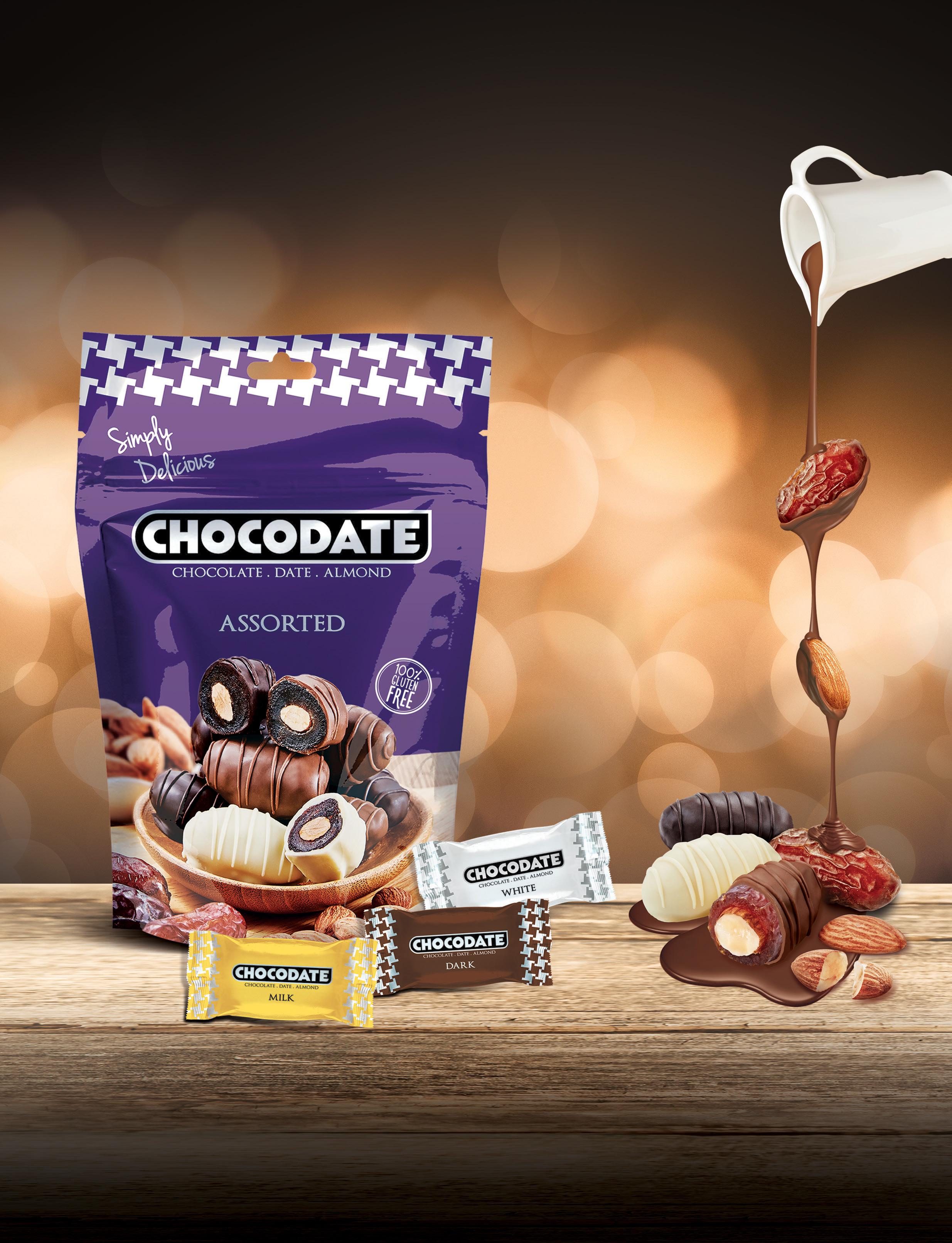
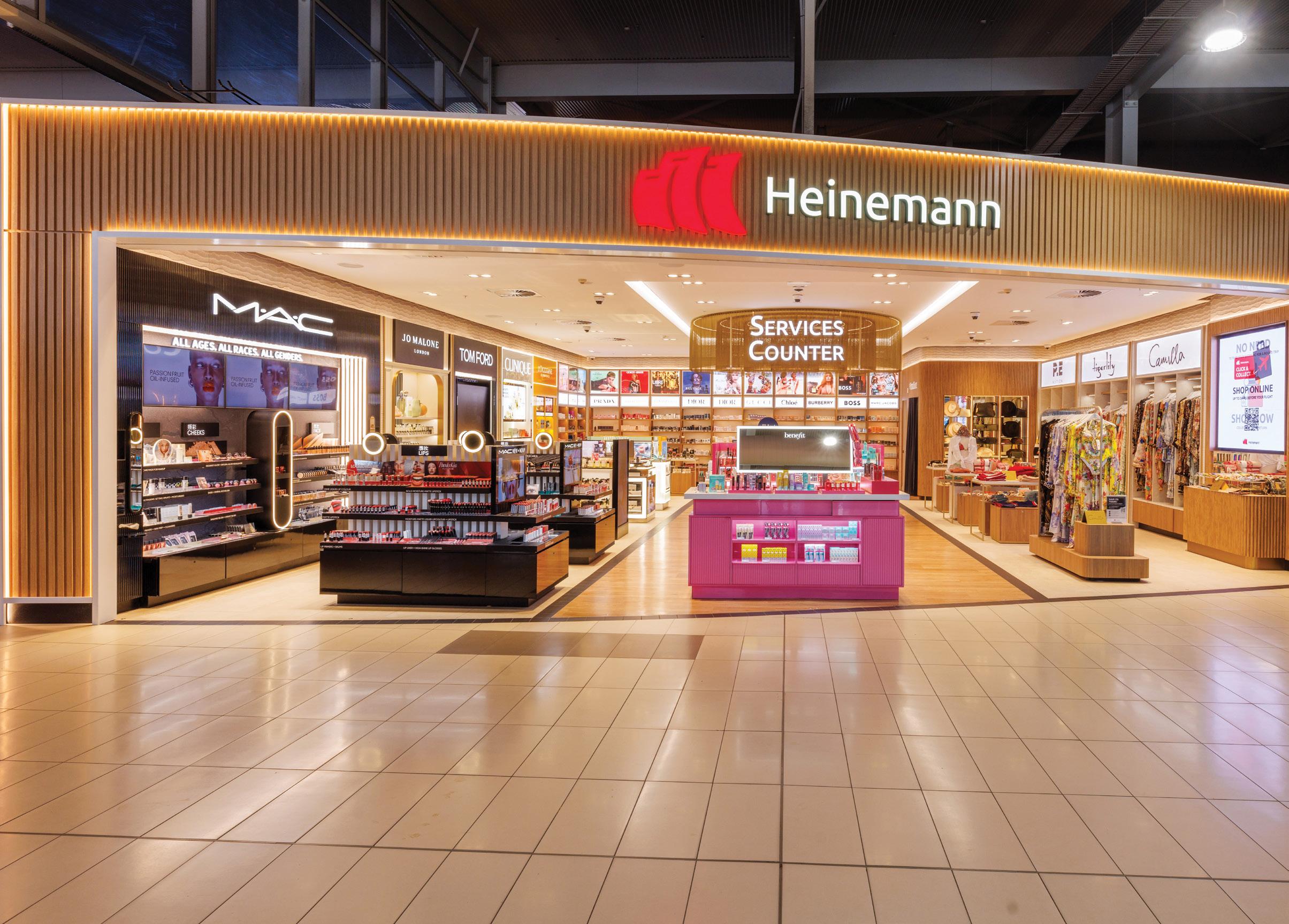
Gebr. Heinemann continues to focus on airside and domestic locations as part of its growth strategy in Australia. The company’s CEO Asia Pacific, Marvin von Plato, has spoken about the company’s “focus on outreach to non-travelers and on landside property development,” which has so far proven to be a shrewd direction, increasing awareness among domestic customers of the company’s retail offer on Australia’s east coast.
Von Plato says the company was pleased to start operations at the Sydney and Gold Coast Airport terminals last year with a strong response from
Gebr. Heinemann has its sights set on expansion in the Australian domestic market, as the prominent travel retailer reports strong trading after recent store launches at Sydney and Gold Coast duty paid airport locations
by ALISON FARRINGTONtravelers that has grown every month as more passengers became aware that Heinemann’s duty paid offer is available domestically now. “This has reinforced our value proposition of a world-class retail offer even in domestic; traditionally these kinds of luxury and premium concepts have been reserved for international duty free,” he tells Global Travel Retail Magazine.
More opportunities
Heinemann’s newfound presence in domestic airport retail is a boon for its brand profile. “It opens up so many doors in terms of passenger engagement that aren’t available in international

terminals,” he says. A great example is the retailer’s recent fan meet-and-greet event with F1 driver Nico Hülkenberg at its Sydney Airport domestic store a few days before the Australian Grand Prix in Melbourne. As spectators at the Melbourne race are overwhelmingly interstate visitors as opposed to overseas, von Plato says Heinemann was able to engage with more passengers (400+) than it might have been able to in the international terminal.
Building on its existing footprint in the international terminal, Heinemann’s Gold Coast opening in November 2023 has focused on local brands for the fashion and accessories offer, including


22 brands ranging from international luxury to uniquely Australian products, with a full beauty line-up joining soon, according to the company.
“We continue to look for more opportunities to increase the number of touchpoints we have with travelers as part of our goal to be a valuable travel companion and really deepen our footprint in the markets in which we operate,” says von Plato.
With the continued rise of beauty sales in Asia’s travel retail market, Gebr. Heinemann has invested in its beauty offer at Sydney Airport. “The overall
recovery is being driven by the return of Chinese free and independent travelers (FITs), who account for a significant share of the region's travel retail beauty sales,” von Plato says.
“We have dedicated a large space to beauty to offer a more expansive range that includes experiential and boutique spaces for marquee brands like La Prairie, Chanel and Dior,” he adds. These join Hermès, Acqua di Parma, Burberry, Chloé and Fresh, which are all available at an Australian airport for the first time.
Von Plato says Gebr. Heinemann keenly observes market trends in beauty, “We have watched the growth of niche

and independent brands as customers seek out newness and unique products, and clean and sustainable beauty for more conscious consumers. Our Sydney Airport store has been a great stage to launch exclusives and firsts in travel retail given its position in the airport’s ‘luxe precinct’ and the sheer size of the store.”
Heinemann has reopened stores in Kuala Lumpur and Hong Kong recently, in line with its efforts to bring its Asia business back to a pre-pandemic sales performance as quickly as possible.
Von Plato says the retailer’s business






 The beauty offer at Heinemann’s Gold Coast domestic store has a full line-up coming soon
The beauty offer at Heinemann’s Gold Coast domestic store has a full line-up coming soon

in Hong Kong has come back strongly, “In fact some stores have already achieved sales figures comparable to 2019 in some months, an exceptional result considering our Sweet Dreams stores were the last in Asia Pacific to reopen after the pandemic.”
The company has looked to seasonal marketing to boost its regional appeal in Hong Kong. “We received strong support from various partners, resulting in a greater number of brand promotions compared to the previous year,” explains Von Plato.
Heinemann officially unveiled its
redesigned store at KLIA Terminal 2 international departures in May last year while the travel retail market was still slow in Malaysia. “We took the opportunity to redevelop our shops during the post-COVID recovery period, ensuring we feature a wide array of new and exclusive brands,” says von Plato. “These include beauty brands Helena Rubenstein and Sol De Janeiro, with Jelly Cat soft toys as additions to our exclusive brand line-up, contributing to our sales growth this year.”
Von Plato says this location’s success has been down to ever-changing brand

activations across the wide array of fragrances, skincare, cosmetics, watches and jewelry and confectionery categories. “It was important to feature an impressive assortment of new launches, travel retail exclusives and value options while running strong seasonal campaigns with Malaysia Airport to keep our travelers fully engaged and excited.”
Next, von Plato is working on new store openings coming up at Auckland Airport. “We are very much focused on deepening our footprint in our current markets to truly become a valuable travel companion,” he adds.

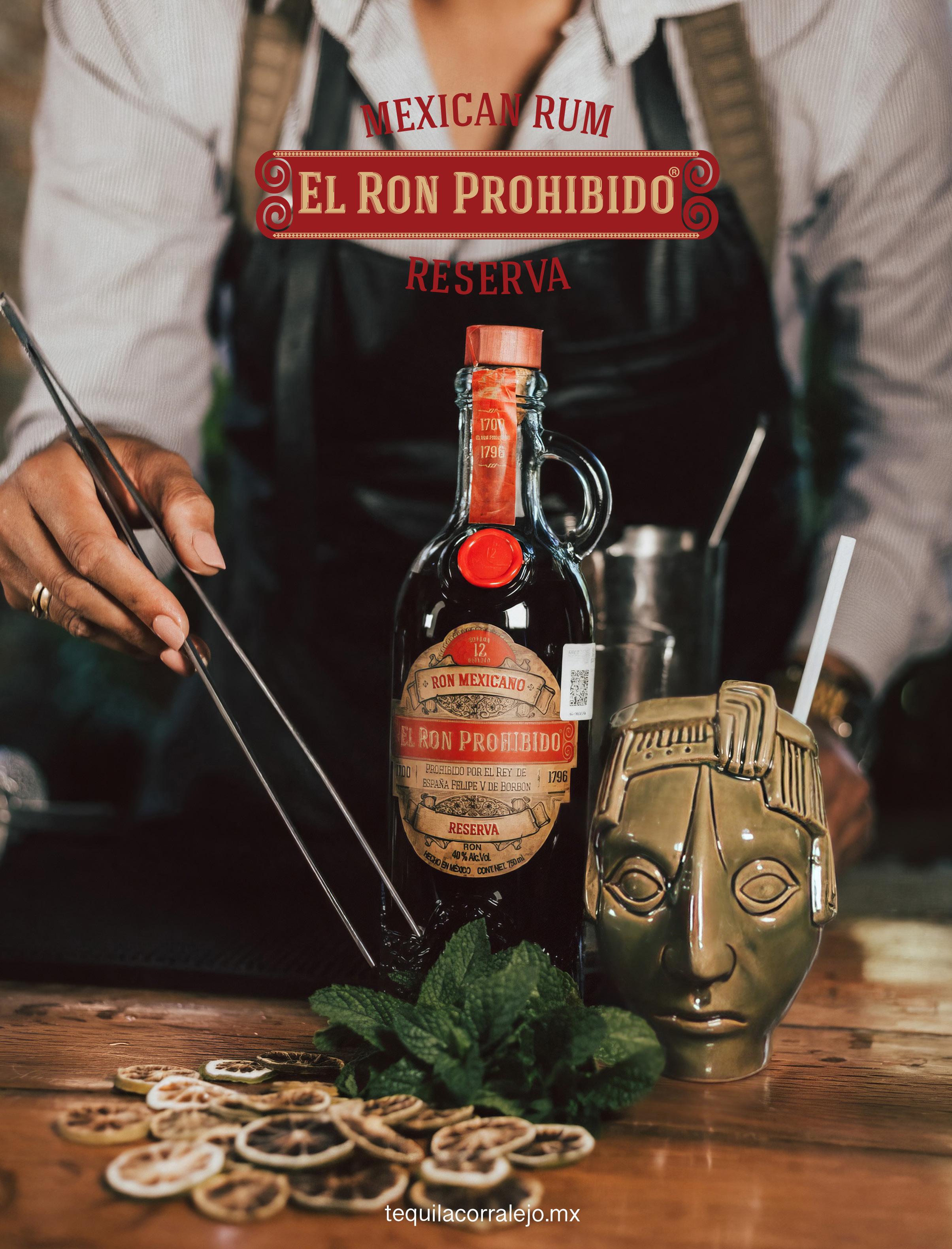

As Chinese outbound travel gains momentum, a new generation of tourists is demanding personalized, sustainable and culturally rich experiences, presenting opportunities for savvy travel retailers to thriveby WENDY MORLEY

The economic power of Chinese tourists continues to be a driving force in global tourism and related industries, including travel retail. The resilience of China's luxury market and its expected steady growth underline a recovery in consumer confidence and a resurgence in international travel post-pandemic. This shift is poised to benefit the global hospitality and retail sectors, offering broader economic advantages.
The luxury travel market is evolving to cater to the changing preferences of affluent Chinese tourists, fulfilling the desire for unique, high-quality experiences. This market is anticipated to grow significantly, its value projected at US$1.38 trillion in 2023 with an expected 7.9% CAGR from 2024 to 2030, with growth fueled by the increased spending capacity of elite
travelers, the popularity of micro-trips, and a booming global tourism sector, according to global management consultants Bain & Company.
The travel and shopping behaviors of Chinese tourists show a clear preference for destinations that are not only vacation spots but also cultural and experiential hubs. Increasingly, they seek immersive experiences that offer a deeper connection with local cultures rather than traditional sightseeing or shopping.
We are seeing significant changes in traveler demographics and preferences within this cohort. Gen Z has emerged as a crucial demographic, comprising about 30% of new Chinese travelers. These younger tourists, often with stable incomes, are opting for unique experiences to share on social media. They tend to travel to geographically closer destinations to maximize experiences on shorter trips. This group prefers to engage in luxury shopping at home more than abroad.
Sustainability has become crucial in travel and consumption decisions, with an increasing number of Chinese tourists opting for eco-friendly travel
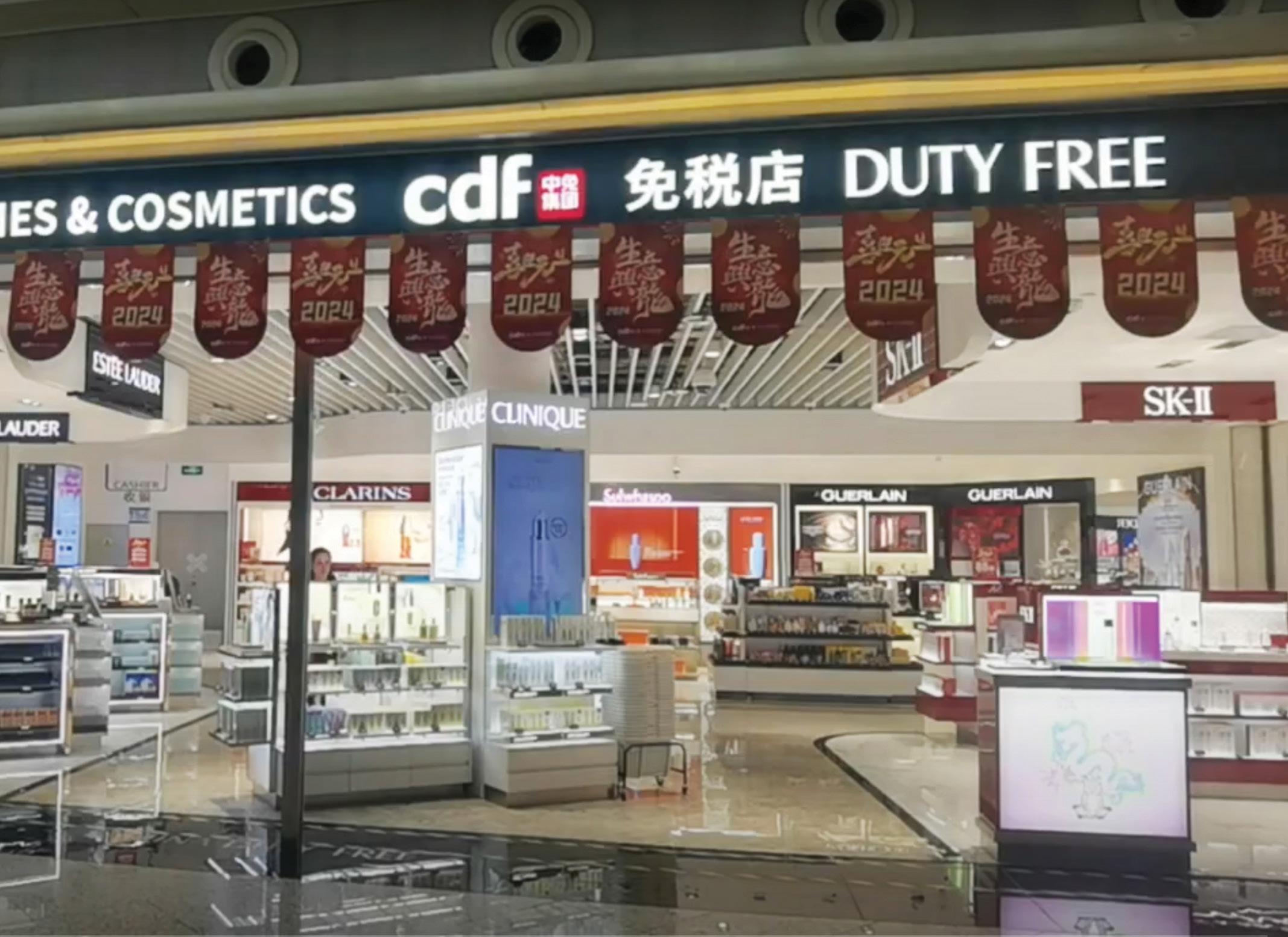
options and prioritizing destinations that emphasize environmental conservation. This trend extends to their shopping habits, favoring products that are ethically sourced and environmentally sustainable.
Outbound travel, while increasing, is not expected to reach pre-pandemic levels until 2025, though Chinese domestic travel is booming, according to Economist Intelligence. This year has seen a significant expansion in flights to popular destinations such as Thailand, Japan and various European capitals from China, however, with airlines sometimes doubling or even tripling flights to key destinations, especially during peak travel seasons like the Lunar New Year and Golden Week.
Destination-specific marketing has become more sophisticated, utilizing both digital and traditional media to attract Chinese tourists. Jing Daily states that collaborations between tourism boards and travel agencies are producing tailored offerings that highlight unique cultural experiences and highquality shopping opportunities. These
marketing efforts are supported by digital campaigns on platforms popular in China, such as WeChat and Weibo, which not only raise awareness but also simplify travel planning and booking, increasing the overall appeal of these destinations.
ITB China reports that the travel behaviors of Chinese tourists are increasingly shaped by advanced digital tools and platforms such as Ctrip, Qunar and Fliggy. Travel apps offering AI-powered recommendations, virtual reality previews and personalized itinerary planning are revolutionizing how journeys are planned by streamlining the planning process and providing personalized travel experiences based on individual preferences. Additionally, social media platforms play a critical role in travel decision-making, offering a mix of inspiration and practical advice that influences destination choices.
While travel has picked up since the reopening last year, the economic slowdown in China is dampening the recov-
ery pace of outbound tourism, affecting Chinese travelers' spending abroad and necessitating adjustments in business strategies to remain attractive to this key demographic. However, this scenario also drives innovation in catering to evolving preferences for more personalized and culturally relevant experiences.
Businesses can enhance their appeal by offering services such as Mandarinspeaking staff, Chinese food options, and popular Chinese payment platforms like Alipay and WeChat Pay, states Jing Daily. Digital engagement is crucial, and the convenience of these familiar platforms significantly impacts the travel decisions of Chinese tourists.
Additionally, the influence of Key Opinion Leaders (KOLs) and influencers on platforms like Douyin and Little Red Book is pivotal. Collaborations with these figures can drive awareness and attract tourists through aspirational content that showcases unique experiences and brand offerings.
As projected by Travel Daily News China, the trajectory for Chinese outbound tourism will not only recover to pre-pandemic levels but will continue to climb. The allure of global travel for Chinese tourists is not just rebounding; it's evolving with promising vigor. China's intensified desire to traverse international borders is anticipated to play a pivotal role in the global travel dynamics, fostering an era of unprecedented growth for the industry, especially in luxury retail.
With a robust increase in outbound travel from China expected, the ripple effects will be felt across various global destinations. Chinese travelers are increasingly venturing beyond traditional tourist spots, seeking out unique and upscale experiences. This shift is creating fertile ground for businesses worldwide to innovate and cater to this lucrative segment, which shows a growing preference for premium services and exclusive offerings.


With a keen understanding of consumer trends, Jessica’s Secret uses cutting-edge technology to craft a seamless shopping experience for travelers, prioritizing intuitive design and strategic partnershipsby HIBAH NOOR
to the evolving preferences of Chinese travelers. His insights reflect a strategic commitment to enhance the travelers journey through technological innovation and user-centric features.
As the digital frontier of retail continues to expand, Jessica’s Secret has firmly positioned itself at the vanguard of travel retail’s digital transformation. Mirko Wang, CEO of Jessica’s Secret, has a clear vision on navigating the surge in online duty free shopping, especially when it comes
“From my perspective, online duty free shopping has always been a trend in the Chinese travel retail market,” he says. “Especially during the past few years of the epidemic, Chinese travelers have become more accustomed to using e-commerce to solve shopping problems, searching for which products are available at their destination before setting off.”
The foundation of Jessica’s Secret’s approach is to seamlessly connect users with a world of retail opportunities while offering unique functionalities
designed to simplify and enrich the user experience. “Jessica’s Secret has always been positioned as a bridge between the travel retail industry and travelers. There’s a direct jump function in the the app which travelers can use to go directly to the website of the retailer or brand. This function helps to lead traffic to retailer or brand sites from our app,” he notes.
The commitment to fostering an intuitive shopping experience extends to Jessica’s Secret’s strategic use of data to inform purchase decisions. “Jessica’s Secret helps and guides travelers to make purchasing decisions in the form of a price indicator calculated by utilizing powerful price database resources from all the retailers,” says Wang. “In addition, some retailers and airports have launched coupons on Jessica’s


Secret aimed at attracting more travelers to shop there.”
According to Wang, the platform has always served both the travel retail industry and travelers, particularly in the Chinese market. “Jessica’s Secret has always been positioned as a bridge between the travel retail industry and travelers,” he says.
In response to the dynamic growth of China’s travel retail market, Jessica’s Secret is implementing strategic initiatives to amplify its market presence and enhance performance. Wang details the company’s approach to engaging a growing user base and maximizing the utility of its platform for both travelers and retail partners.
Jessica’s Secret has now launched a member reward program, which is divided into four levels based on the member participation. “The purpose is to encourage travelers to use the app and its coupons more frequently while shopping,” Wang says. This tiered
rewards system is part of the company’s broader strategy to incentivize usage and increase engagement.
Wang says the innovative business model is designed to benefit the Jessica’s Secret community. “In the process of cooperating with retailers and brands, Jessica’s Secret may earn promotional fees or commissions. But earning these profits is not our purpose. We hope users can get more benefits, so we give these commissions to users in the form of points to the greatest extent, so as to increase our share of the coupon market,” he states.
While Wang says gauging the app’s tourism market share is difficult for to estimate, but those who use it are exactly the right people for travel retail brands and stores to reach. “It’s probably around 10 to 20%,” he says. “But users of Jessica’s Secret are all precise consumers, 100% of which are tourists who have purchase need. Depending on the coverage of coupons and the tacit cooperation with local retailers and brands, we will have a relatively large impact.” This
insight reflects the strategic importance of targeted partnerships and the effective distribution of benefits to sustain and grow the platform’s influence across key travel retail markets.
Jessica’s Secret’s approach to collaboration with brands and retailers exemplifies a dynamic synergy aimed at enhancing the user experience while boosting the visibility of its partners. The company’s promotional strategies emphasize the importance of cooperative relationships in the travel retail landscape. “We have many ways to cooperate with retailers, such as charging commissions and advertising fees which we give back to users, as mentioned. In addition, we also provide retailers with a lot of free advertising spots, like a banner on the homepage, for example,” Wang explains. Wang believes travel retailers are an important link in motivating tourists to shop. Therefore, Jessica’s Secret will not block communication between retailers and users if retailers have not
 Jessica’s Secret already provides an AI Tracking analysis system for “almost all” leading brands and retailers in the industry
Jessica’s Secret already provides an AI Tracking analysis system for “almost all” leading brands and retailers in the industry

Jessica’s Secret’s team developed the “Watches & Wonders” Exclusive Virtual Expo
paid promotion fees. Instead, retailers are welcomed to display promotional activities on the app for free. This inclusive approach to collaboration invites a broad spectrum of retailers to engage with Jessica’s Secret users, ensuring a rich and diverse shopping experience.

“Now we have cooperation with many retailers, and we welcome more retailers to contact us for cooperative promotion to Chinese tourists,” says Wang. By fostering these collaborative efforts, Jessica’s Secret not only enhances the promotional landscape for brands and retailers but also positions itself as a pivotal platform in connecting the travel retail industry with a highly engaged traveler base.
The secret formula
Jessica’s Secret leverages a multifaceted strategy to attract and retain a robust user base, a critical factor in its success within the fiercely competitive domains of price comparison and travel retail. Wang details the strategic pillars supporting the app’s continuous growth and user satisfaction.
“We achieve attraction and retention in two ways: first, we provide travelers with more valuable functions; second, we collect and calculate various preferential and promotional information for travelers,” Wang says. This dual approach ensures that Jessica’s Secret remains not just relevant but indispensable to its users by offering unique functionalities and up-to-date promotional content.
Wang highlights the app’s innovative price indicator as a key feature, “Jessica’s Secret now provides travelers with
many interesting functions, such as the price indicator. Each score is calculated according to a grading algorithm mode on a scale of 0.1 to 10; 0.1 would be the highest price among all the data we collected worldwide, 10 means the lowest price. This feature helps travelers quickly discover which products are worth buying from this retailer.”
Jessica’s Secret also provides travelers with the ability to scan barcodes, quickly finding global price information. Soon, the app will include a “Gift with Purchase” feature, and a comparison of payment method exchange rates.
Jessica’s Secret adheres to rigorous data privacy and security protocols, with a dedication to safeguarding user information. “In recent years, China has continuously promulgated new personal information protection laws and policies, including information collection methods, collection purposes, usage methods, storage times, etc., to protect the legitimate rights and interests of Chinese travelers. Jessica’s Secret has been audited by China’s network information security department and has reached relevant standards,” Wang explains.
“In terms of actual operations, we have strengthened the creation of a network security environment to pre-

vent outsiders from intruding into our systems and stealing data,” he adds. “We have also signed information confidentiality agreements with our employees, etc., and have made improvements in all aspects.”
Wang describes how a typical Jessica’s Secret app user experience, “Half a month before traveling to a certain destination, travelers begin to frequently use Jessica’s Secret to find price information and discounts, sometimes completing product reservations during this process owning to a promotion offered by the retailer,” he says. During the journey, the app will push the duty free shops’ coupons information to users, and encourage them to visit the store.
Not only are travelers using Jessica’s Secret app, but some retailers are also cleverly using it to achieve higher sales conversions. “One traveler told me that when she was buying a necklace at an airport, the salesperson took out Jessica's Secret app and showed her the real-time price of this necklace in Hong Kong, Japan, and Taiwan, and the price she offered was the most competitive. So the traveler made the purchase decision immediately.” Wang recounts.
In response to global changes and emerging trends within the travel retail
industry, Jessica’s Secret has undergone significant transformation and expansion. “Before the pandemic, my company mainly provided service to customers. After the pandemic, we have evolved into a comprehensive big data company serving business and customer,” he states.
The introduction of innovative tools and services has enabled the company’s evolution, “We provide an AI Tracking analysis system for many top-renowned brands and retailers. Almost all the leading brands and retailers in the industry are already using our price analysis system,” Wang says. This tool represents a cornerstone of Jessica’s Secret’s value proposition, offering detailed insights into pricing strategies across the travel retail channel.
As part of a partnership, Jessica’s Secret regularly creates and releases the OTRO (Oriental Travel Retail Observer) report, further demonstrating the com-
pany’s commitment to delivering actionable intelligence to its partners. “We create a monthly report called OTRO, with multiple leading brands and retailers subscribing. We have served many big brands for more than four years,” Wang notes, highlighting the company’s role as a thought leader and information hub in the travel retail space.
Including design and IT, this is just one of the ways Jessica’s Secret caters to the nuanced needs of its business partners. “Jessica’s Secret IT department provides IT services to KingPower and CDFG, including the development and operation service of Chinese e-commerce website and membership mini-programs,” Wang states. These services, combined with Jessica’s Secret’s indepth market research capabilities and cost-effective design solutions, solidify its competitive edge and position as a comprehensive service provider in the travel retail industry.

(OTRO) is the first travel retail industry report generated from a Chinese perspective. It includes monthly sales data of duty free retailers in Hainan, transaction prices of key SKUs of wholesale trading in Hong Kong from South Korea, latest industry dynamics, regulations, brands, key SKU price changes and interview takeaways with industry experts and/or wholesale Daigous

Industry visionary, Portland Design’s Ibrahim Ibrahim calls for airports to embrace their potential as dynamic place brands, creating enriched environments that foster community and deepen brand engagementby WENDY MORLEY
In an era where every touchpoint can influence brand perception, airports have a unique opportunity to redefine their roles not just as transit points but as dynamic, influential place brands in their own right, says Ibrahim Ibrahim, Managing Director of Portland Design, renowned for his forwardthinking approach to design, branding and commerce.
Ibrahim envisions a compelling vision for the future of airports. His insights highlight the transformative potential airports hold, moving beyond conventional revenue models to become vibrant, community-centric spaces that resonate deeply with travelers and consumer brands alike.
Branded value
Ibrahim challenges the status quo, pointing out a significant oversight in
how airports have traditionally viewed their own function and potential.
“Airports have the potential to be the most powerful media platform for any brand, and I believe they are missing that opportunity. When it comes to the commercial offer, airports by and large think in traditional ways, about transaction, about turnover, MAGs (minimum annual guarantees) and rent. There is an opportunity to think of the airport firstly as a brand, to think beyond real estate, beyond a terminal, beyond a shopping center,” he says.
This critique lays the groundwork for a reimagined airport experience – one that prioritizes brand DNA, storytelling, engagement and emotional connection over mere transactions. “It’s about creating the story, defining a clear and compelling proposition,” he says. “I think the future will rest on who owns

Portland Design Managing Director Ibrahim Ibrahim says as things stand airports are missing the opportunity to be the most powerful media platform for any brand, stating they need to think beyond real estate, beyond a terminal, beyond a shopping center
the passenger. And who owns the passenger is a brand issue. I mean, own the passenger emotionally. Airports have an opportunity to really build their brands, and they need to take that opportunity.” This vision extends beyond the physical infrastructure, encompassing the social and digital realms where airports can amplify their presence and engage with a global audience.
Ibrahim sees airports as dynamic place-brands with the potential to enhance loyalty in both B2B and B2C relationships, while also building a strong sense of loyalty within their own teams.

The shift towards seeing airports as powerful brand platforms requires a fundamental change in perspective. Ibrahim points out that many airports lack a compelling social media presence, which is a missed opportunity for enhancing brand loyalty and engagement. He stresses the importance of internal branding, stating, “Much of what we’re doing is internal branding, for brands to engage their own people. It’s very interesting. We’re doing a big piece at the moment for a leading sports brand. And most of what we’re doing is internal branding.”
If an airport is now a dynamic platform that attracts and promotes partner brands, it can leverage its unique position as a brand in its own right. This shift is driven by the understanding that airports, often just seen as transit hubs, hold a captive audience of travelers who, already invested in the act of traveling, display a high propensity to spend. This makes the airport an optimal stage for brands across the duty free categories from spirits to accessories, P&C, confectionery and beyond.
Ibrahim addresses the exceptional value of interactions within this setting,
1. Data-driven media value: Ibrahim states the critical importance of leveraging data to showcase an airport’s ability to generate significant media impressions, suggesting that commercial managers must focus on quantifying and communicating the value of airport spaces as powerful spaces. He says: “They’ve got to be focused on capturing data that can prove an airport can drive media impressions and therefore determine what the value of those media impressions are.”
2. Authentic luxury experiences: While luxury is a focus of the airport retail dynamic, Ibrahim criticizes the lack of genuine luxury experiences. “I don’t believe you can ever have a luxury retail experience if you have to end up along that journey on a conveyor belt like a supermarket,” he remarks. His believes airports must create authentic luxury experiences that go beyond the product to include the entire airport experience.
3. Rethinking commercial spaces: Lastly, Ibrahim advocates for a revolutionary approach to conceptualizing commercial offers in airports. He suggests moving away from traditional retail models towards more engaging and dynamic experiential spaces: “Think about your commercial offer less and less like boxes with glass fronts and shelves with light boxes and more like a stage set that’s programmable.” He adds: “From shelves with products for sale to stages with experiences to share!”
“You can have a click in an airport, and it is very valuable because the person is right there, excited, expectant and ready to spend, engaged in the mindset of travel and discovery.” This insight highlights the value of customer engagement, where the cost per click –

or the cost of engaging a customer – is significantly outweighed by the quality and readiness of the consumer.
The opportunity is to offer more than transactional experiences. If airports create compelling, unique and engaging experiences that passengers feel are

Airport terminals could become multi-use spaces where coworking, learning, and health and wellness join retail, food and entertainment –in line with societal trends toward a more flexible work environment and a greater focus on health and personal development.
NOTE: IMAGE NOT ASSOCIATED WITH IBRAHIM IBRAHIM OR PORTLAND DESIGN


SINCE 1978

worth sharing and exploring when they get back home, the potential for brands is to recruit that passenger and turn them into a customer for life.
“If a brand spends eight cents on a Facebook click that lasts a millisecond, how much would a brand spend for the undivided attention of a fan or a potential customer for 40 minutes?” he muses. “And that passenger in an airport, don’t forget, is an A1 consumer, and is global.” Such interactions extend beyond mere transactions; they build lasting impressions and deepen consumer relationships.
By positioning themselves as brands, airports not only amplify their own identity but also create enriched environments that facilitate deeper connections between travelers and the brands within their premises. This symbiotic relationship fosters a cycle where travelers, influenced by the airport’s branding, become active promoters of the brands they engage with. This enhances brand loyalty and consumer engagement, leveraging the airport’s platform to create a community of shared interests and heightened brand interaction.
The new community Ibrahim’s vision extends beyond branding to the transformation of airports into spaces that incorporate coworking areas, health and wellness centers,
beauty services and opportunities for learning, reflecting broader trends already taking place, and creating environments that cater to the modern traveler’s needs and desires.
Ibrahim is critical of the old model that views airports primarily as shopping centers, stating, “The days of thinking about an airport like a shopping centers may be coming to an end.”
Ibrahim predicts a transformative future for airports, where coworking, learning, and health and wellness become integral components of the airport experience. He sees these elements not just as additions, but as essential features that blend with retail, food and entertainment and align with evolving societal trends towards more flexible work environments and a greater focus on health and personal development.
Envisioning how these services fit into the current airport dynamic, Ibrahim proposes a significant shift. Airports, in his view, have the opportunity to transition from being seen as transport hubs with transactional shopping to becoming vibrant, multifunctional spaces that are less like shopping centers and more akin to town squares.
In practical terms, Ibrahim imagines a day spent at the airport not just in transit but engaged in various activities: a traveler could arrive at the airport early, use a coworking space to catch up
on work, pop in and out for a coffee or a snack, participate in a whisky brand’s educational seminar, receive a haircut, dine at a restaurant, and even complete a workout session at a Peloton or Soul Cycle gym.
He explains that this would change the economic dynamics for airports. Rather than earning primarily from rent and retail turnover, airports could capitalize on the value of media impressions driven by compelling experiences and live streaming, as well as the spending of visitors who engage with multiple services throughout their stay. Ibrahim acknowledges the challenges in implementing these visionary ideas, such as existing infrastructure limitations and contractual obligations.
Ibrahim’s insights offer a compelling vision for the future of airports as multifaceted platforms that deliver experience as well as transaction. His call to action for airports to embrace their brand identity and to innovate in how they engage with travelers and brands alike points to a new direction in the travel industry, where health, wellness, work and learning become integral to the airport experience. This redefined role of airports has the potential to not only enhance the travel experience but also to contribute to the creation of more vibrant, community-focused spaces around the globe.

Committed to delivering worldclass visitor experiences,
Jewel Changi Airport is celebrating its fifth anniversary with a year-long series of special events and retail offers under the theme “What A Feelin5”by HIBAH NOOR


Jewel Changi Airport (Jewel) is celebrating its fifth anniversary with robust growth, recording a 26% increase in foot traffic for the fiscal year 23/24 compared to the previous year, which also saw a 20% increase in sales. Approximately 30% of the visitors were international travelers from China, Malaysia, Taiwan, the United States and Indonesia.
Canopy Park at Jewel, spanning 14,000 square meters, enjoyed a 12% rise in visitor numbers and a 35% surge in sales. Its unique Double Rewards loyalty program, which provides two sets of loyalty reward points for each transaction, witnessed a growth of over 10% in membership.
For its fifth anniversary, Jewel has planned a year-long series of special events and retail offers under the theme “What A Feelin5”, designed to evoke positive emotions through varied experiences. James Fong, CEO of Jewel Changi Airport Development, states, “Five years ago our shareholders –Changi Airport Group and CapitaLand – embarked on a bold mission to redefine the airport experience. Today we stand proud as a global icon well-loved by both local residents and travelers. As Jewel celebrates five years of creating the sparkling experience for its visitors, we continue to stay true to our commitment to deliver world-class visitor

experiences with our attractions, retail, and dining offerings. We are thrilled to announce a series of new flagship store openings and new-to-market brands as well as a behind-the-scenes tour for the Jewel Rain Vortex that has long captured the imagination of our visitors. New experiences and a series of events and Jewel-exclusive offerings will also be introduced throughout the year.
“As we look forward to more exciting years ahead, we wish to thank Singaporeans and guests from around the world for their love and extend our appreciation to our tenants and partners who have stood shoulder to shoulder with us all this time."
A new Light & Music showcase called “What A Feelin5” has been launched, featuring a five-minute show created by WET, incorporating elements like Jewel’s iconic façade and the local flora. Additionally, a new tour named “In the Eye of the Jewel Rain Vortex” will be available from the latter half of the year, providing a close-up view of the world's tallest indoor waterfall and insight into daily preparations at Canopy Park.
Jewel will host a series of marquee
events throughout the year, starting with “Jewel Blooms” during the June school holidays, from May 24 to August 11. This event will feature floral installations inspired by various emotions, designed in collaboration with Singaporean garden designer Andy Eng and Japanese floral artist Megumi Shinozaki. Additionally, Canopy Park tickets are on sale, and the Youth Floral Cup will reopen for young participants aged 7 to 12. Over 50 special collaborations and exclusive perks will be available across Jewel's retail and dining sectors as part of the anniversary celebrations. These include a Singapore-exclusive cold cup from Starbucks featuring the Rain Vortex, a Jadeite Pendant from Asian Artistry Fine Jewellery, and a Morgan Bow Handbag from Kate Spade, among others. Unique dining options will also be available, like the Cereal Lobster from Burger & Lobster and the Bejeweled Bombe from Sourbombe Artisanal Bakery.
Redefining the retail experience, Jewel is gearing up for numerous new store openings in May and June, including several flagship stores. Aligning with its
ethos of “Where the World meets Singapore, and Singapore meets the World,” the venue will host a variety of local and international brands. CHARLES & KEITH, a Singaporean fashion label, is set to expand its presence with its first flagship store at Jewel located in Basement 1. Other flagship stores include FILA’s first in Singapore, occupying a duplex at Level 2, Bimba Y Lola with its largest store in Singapore at over 1,600 square feet (149 square meters) on Level 1, and New Era at Level 2, offering unique customization services. Additionally, new-to-market brands such as IPOH TOWN, which offers traditional Ipoh cuisines, Nai Xue with its health-focused tea beverages, fashion and accessories brand SETIROM, Parisian jewelry brand Satellite Paris, and Royal Host, a popular Japanese family restaurant, are also making their debut at Jewel.
As Jewel commemorates its fifth year, it will partner with Metta Welfare Association (Metta) for a charity event. The proceeds from this event, including an auction, will support the new Maitri School/Building project, scheduled for completion by 2028. Maitri School will be Metta's second Special Education School, dedicated to educating students with moderate to severe Autism Spectrum Disorder (ASD). Twelve auction items have been donated by Jewel’s tenants for this event, including a limited-edition Louis Erard x seconde/ seconde x Watches of Switzerland watch and a BE@RBRICK FLOR@ collectible featuring a bouquet of red roses in its transparent torso. The highly coveted BLACKPINK x Starbucks® collection of tumblers, cold cups, and water bottles will also be available for bidding. For more details about the auction items and to place bids, visit the public bidding section available until April 21. For further details on the anniversary celebrations and to view the full lineup of events, visit Jewel’s dedicated 5th anniversary website.


Based on input from aviation industry experts and data analysis, Global Travel Retail Magazine reports on air connectivity in Asia Pacific, domestic vs. international growth in China and the potential of the Southeast Asian market within air travelby LAURA SHIRK
Serving as both a source and destination region, the increase of international visitors within Asia Pacific (APAC) is supported by Asia, with mainland China playing a key role in traffic flow. Elaborating on the current state of the travel industry in APAC, Joanna Lu, Head of Consultancy Asia at Cirium Ascend Consultancy, notes Cirium’s data shows the most improved international connection to APAC countries is led by United Arab Emirates, with departing international seats up 15%. “However, the main international connection is still driven by the capacity within Asia,” she says. According to Lu, Singapore, Japan and South Korea are the three markets generally recovered from the pandemic; China outbound travel to APAC is still almost 30% down versus 2019. “The main source(s) of inbound seats for Southeast Asia are also mainly from within the region, with Indonesia, Malaysia,
Singapore and Thailand leading. China inbound seats has only recovered to around 60% of the 2019 level,” says Lu.
In February of this year, Asia Pacific airlines saw passenger demand grow 53% year-on-year, which indicates international traffic to and from the region is still surging toward pre-pandemic figures. “The 2023 international passenger demand for Asia Pacific airlines recovered to 72.7% of 2019 levels,” shares Dr. Xie Xingquan, Regional Vice President for North Asia at International Air Transport Association (IATA). “International traffic within Asia reached 66.2% of 2019 levels in 2023, while the traffic between Asia and the Southwest Pacific reached 77.3%.” He says this is similar to the recovery in other markets where restrictions were removed earlier.
Speaking about the challenges in terms of restoring full connectivity and advancing traffic and financial recovery, Lu argues the concept of “full connectivity” does not exist, since changing environmental factors often results in the shift of travel patterns, which impacts traffic and capacity.
“Geopolitical tensions and regulatory hurdles can disrupt aviation connectivity and hinder the growth of the sector. Fostering regional cooperation and harmonizing regulatory frameworks are essential for promoting a healthy environment for aviation development in Asia Pacific.


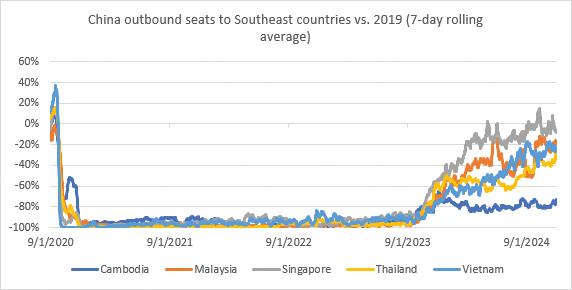
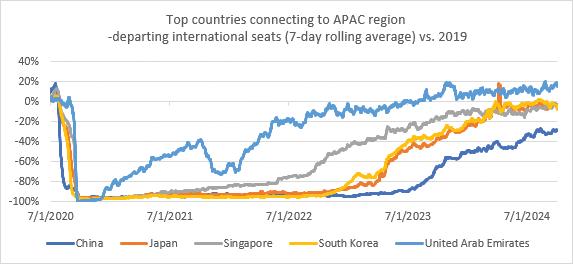
Cirium’s data shows the most improved international connection to APAC is led by United Arab Emirates, with departing international seats up 15%
“The pandemic has led to significant disruptions in aircraft supply chain, airlines’ financial performance, and has reshaped human lifestyles, consumer preferences and behaviors, with a growing emphasis on health, safety and flexibility. Airlines and airports need to adapt their business models and service offerings to meet evolving customer expectations,” says Lu.
On how airlines have refocused their priorities considering the slower return of the Chinese market, Xingquan comments while domestic traffic in China has experienced far more growth than international traffic there is reason to be optimistic. From the reinstatement of its 144-hour-free-transit policy at certain points of entry to the extension of visa free travel to a number of Asian and European countries, government efforts are in place to relax visa conditions for foreigners.
In the case of Chinese travelers, the segment has shown a growing interest in cultural and nature-based tourism experiences such as visits to historical landmarks, heritage sites and natural attractions. “Family and group travel remain popular among Chinese travelers, especially for multi-generational
trips and special occasions,” says Lu. “Travel packages and services catering to families including child-friendly accommodations and activities are likely to be in demand.” Also, a “relatively small” percentage of Chinese travelers continue to value quality experiences and luxury travel options.
As discussed at Routes Asia 2024 in Langkawi, Malaysia, the Southeast Asian market is on track to be among the fastest-growing regions in the world and the untapped potential within the air travel industry is unmatched. Speaking at the event in February, ACI Asia Pacific and Middle East Director General Stefano Baronci remarked that Indonesia is expected to rank fourth among the globe’s busiest passenger markets by 2042. ACI estimates the Philippines, India, Indonesia and Thailand will top the fastest-growing markets between 2023-42, with CAGR between 6.2%-7.2%.
“Typically, any long-term growth in passenger demand is driven by macroeconomic and demographic factors. And how airlines will respond to this projected growth is a matter for
individual airlines to decide. What is key is that if the industry is to continue growing, it needs to do so sustainably. Airlines committed to Net Zero 2050 in 2021. This was reinforced by the longterm aspirational goal commitment by International Civil Aviation Organization member states in 2022,” explains Xingquan.
According to data collected by OAG for April 2024, total airline capacity in Southeast Asia was 38.8 million seats (59% domestic; 41% international), which is down 9.8% versus April 2019. Total seat capacity in the region increased 12% compared to April 2023. Regarding seats by country, Indonesia remained the highest ranked country at 11.9 million seats and accounted for 31% of the region’s air capacity; Thailand ranked second at 6.9 million seats and accounted for 18% of the region’s capacity. The leading data platform for the global travel industry reported the top domestic route in Southeast Asia remained Hanoi (HAN) to Ho Chi Minh City (SGN); Singapore continues to be a key international hub in the region, home to six of the top 10 international routes in the region starting or ending there. Plus, Lion Air remained Southeast Asia’s largest carrier by seat volume, with 3.4 million seats (based on departing seats). The airline’s capacity last month was 14% higher than in April 2019.
“The expansion of low-cost carriers [in APAC] has a significant impact on stimulating travel and tourism within the region. This, in turn, contributes to the growth of the tourism sector by increasing visitor arrivals, supporting local businesses, and generating economic activity in destination cities.
“Successful low-cost carriers continually expand their route networks to tap into new markets, increase market share, and capture passenger demand. This involves identifying underserved routes, launching new routes with high demand potential, and strategically positioning hubs to facilitate seamless connections,” concludes Lu.


VISIT US AT THE TFWA ASIA PACIFIC EXHIBITION & CONFERENCE
SINGAPORE
STAND BASEMENT 2-G18 MINI TREATS IN A RE-USABLE

In this exclusive interview with Global Travel Retail Magazine (GTR Magazine), Charlotte Birley, Managing Director at experiential marketing agency ALIVE, sheds light on the innovative strategies and groundbreaking initiatives of the Singaporebased company. ALIVE, renowned for its unique blend of experiential and personalized marketing solutions, is setting new standards in the travel retail sector. With a focus on bridging the gap between physical and digital realms, Birley discusses the company's latest venture, Aviator, and its transformative impact on navigating the complexities of airport marketing.
GTR Magazine: On the company’s website, the team at ALIVE is described as not human beings, but “humans doing.” How does this thinking help the company to set itself apart from its competitors?
Charlotte Birley (Birley): ALIVE has established a culture of serving and acting with intention and accountability. That means training and empowering everyone in the business to be better lis-
teners, critical thinkers, problem solvers and decision makers. This type of culture drives performance and ultimately client outcomes for everything we do.
GTR Magazine: How does ALIVE provide intuitive solutions that seamlessly cross the divide between physical and digital? Describe its approach to experiential and personalized marketing.
Birley: ALIVE’s approach to navigating the digital and physical divide is encapsulated in a mindset we call IRL Marketing. We think about people as people, not consumers, and we work out where a particular brand message fits into the audience’s real life. This means every experience is fundamentally context driven, not media driven. Everything creatively or technologically downstream needs to serve the message and the context.
GTR Magazine: What is the purpose of Aviator? Why is it a priority to tap into the travel and aviation sector, particularly in this region?
Birley: Aviator has been built to help brands and agencies overcome the com-

plexities and inefficiencies of activating in airports and travel retail stores in hard-to-reach places. Asia is a vastly diverse continent with multiple time zones, cultures and languages, which can be intimidating for brands wanting to market their products. There are 638 airports in Southeast Asia alone and almost three times that across Asia Pacific (APAC), so in the first instance, knowing how to effectively do business here and managing brand representation in retail stores can be enormously challenging, especially for smaller brands with smaller marketing and sales teams who are perhaps based overseas.
For example, let’s say you have a boutique fragrance brand from Europe that needs to understand how its brand is displayed in 100 stores in 15 countries across Asia. Using the knowledge and contacts held within our Aviator database, we can seamlessly conduct daily, weekly, monthly or quarterly store visits using local staff to act as the eyes and ears of the brand. This is cheaper and faster than flying representatives

around the world from Europe, it avoids the administrative hassles of getting multiple airside passes, and also reduces the brand’s carbon footprint.
The APAC travel retail market is one of the fastest growing marketplaces for luxury goods and tax-free shopping, with passenger numbers in many countries back up to or exceeding pre-pandemic levels. Our goal with Aviator is to enable brands to maximize the marketing opportunities here, whether that’s pop-up activations, product launches, merchandising or top-door auditing.
GTR Magazine: How did the company develop Aviator’s knowledge base?
Birley: Aviator was our COVID project. From early 2020 to mid-2021, we had plenty of time on our hands and not much business coming in so we spent many days, weeks and months painstakingly gathering data on the top 50 airports in the region. The first 10 years of my career was spent in airports with JCDecaux Airport in London (UK) and then Blackjack Promotions, so I know all too well the pain-points and potential roadblocks when working in airports. We built a checklist of key information required – DF contacts, approved vendors, operational and security requirements, access routes, media owners, spaces, stores and more –and manually input it all into a database that now sits internally at ALIVE.
Four of our team worked on developing the Aviator knowledge base – there was a lot of Googling! We had to interrogate and check the data: calling people to make sure we had the most up to date information; doing virtual meetings with media agencies and airport owners and store contacts in each city or country; meeting staffing agencies and understanding their services and capabilities and everything in between. And then, when the world re-opened in 2022, we had to check it all again because people had changed jobs, spaces in the airports had been repurposed, terminals had been renovated or moved,
so it was and continues to be a neverending, however, rewarding journey.
GTR Magazine: How does this service streamline the planning and activating of airport campaigns?
Birley: We know first-hand how time-consuming it is to gather all the information you need to plan and activate an airport campaign. Even in your home country, it can be frustrating to get the information you need from key stakeholders and establish trust with approved airside vendors, so trying to do it in overseas locations in a different language and time zone can be even more painful. Now sure, the big brands have agencies that handle this pain for them but even those agencies sometimes need a helping hand, and this is where Aviator comes in.
The Aviator service effectively takes the pain from the brand or agency and transfers it to ALIVE. And we love the pain! Make no mistake – activating in a secure environment is always going to be challenging and complicated, Aviator doesn’t make the process easy – but by having a single point of contact from our team who handles all the liaison, approvals, operations, production and manpower, the process is simple and painless for the end client.
GTR Magazine: When it comes to designing and executing marketing campaigns, how does the airport and travel retail setting offer different opportunities and challenges compared to ALIVE’s more traditional business?
Birley: Everyone in travel retail understands the benefits of marketing to a captive audience with high spending power and time to kill. The airport environment provides access to people in a different mindset to those in a shopping mall or a city center. Whether they’re traveling on business or for leisure, their receptivity moments for brand engagement are more pronounced and more frequent.
When we’re designing a brand experience, we have to put ourselves into the mindset of our customer – as our agency strapline says, “We put people at the heart of everything we do.” We think about how they feel, what they expect, what they care about, what they will be prepared to do, what they will engage with and remember, and what they will capture and share.
The opportunities at the airport far outweigh the challenges – operationally, once you know the limitations on production materials and methods, sight lines, health and safety and security, an airport is like any other venue. The opportunities, on the other hand, are almost endless. Passengers traveling through an airport want a great experience in every sense – from the check-in hall to the departure lounge, to the shopping to the gate – and brands have the chance to positively disrupt this journey with creatively brave marketing that supports a human need or desire.
GTR Magazine: What is ALIVE’s greatest success story?
Birley: Our greatest success story is our team. We’re incredibly proud of the people who make up ALIVE and are deeply grateful for their dedication, their professionalism, their humor, and their commitment to doing the best job possible.
We’ve managed to retain some of our best original talent through the challenges of recent years and it’s incredibly rewarding to see people rising up through the ranks, growing into leaders and surprising themselves with what they’re capable of. Every day in this business brings a new adventure, so being on a ride with people who you know you can always count on makes all the difference in the world.
It's a massive cliché but we feel like a family unit and I’m sure that’s one of the things that brings our clients reassurance when working with ALIVE. People are at the heart of everything we do.





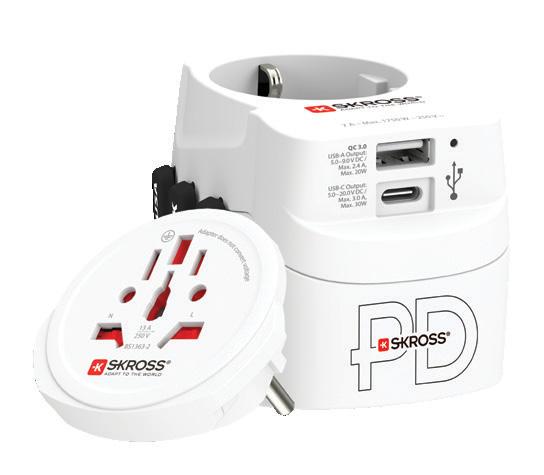



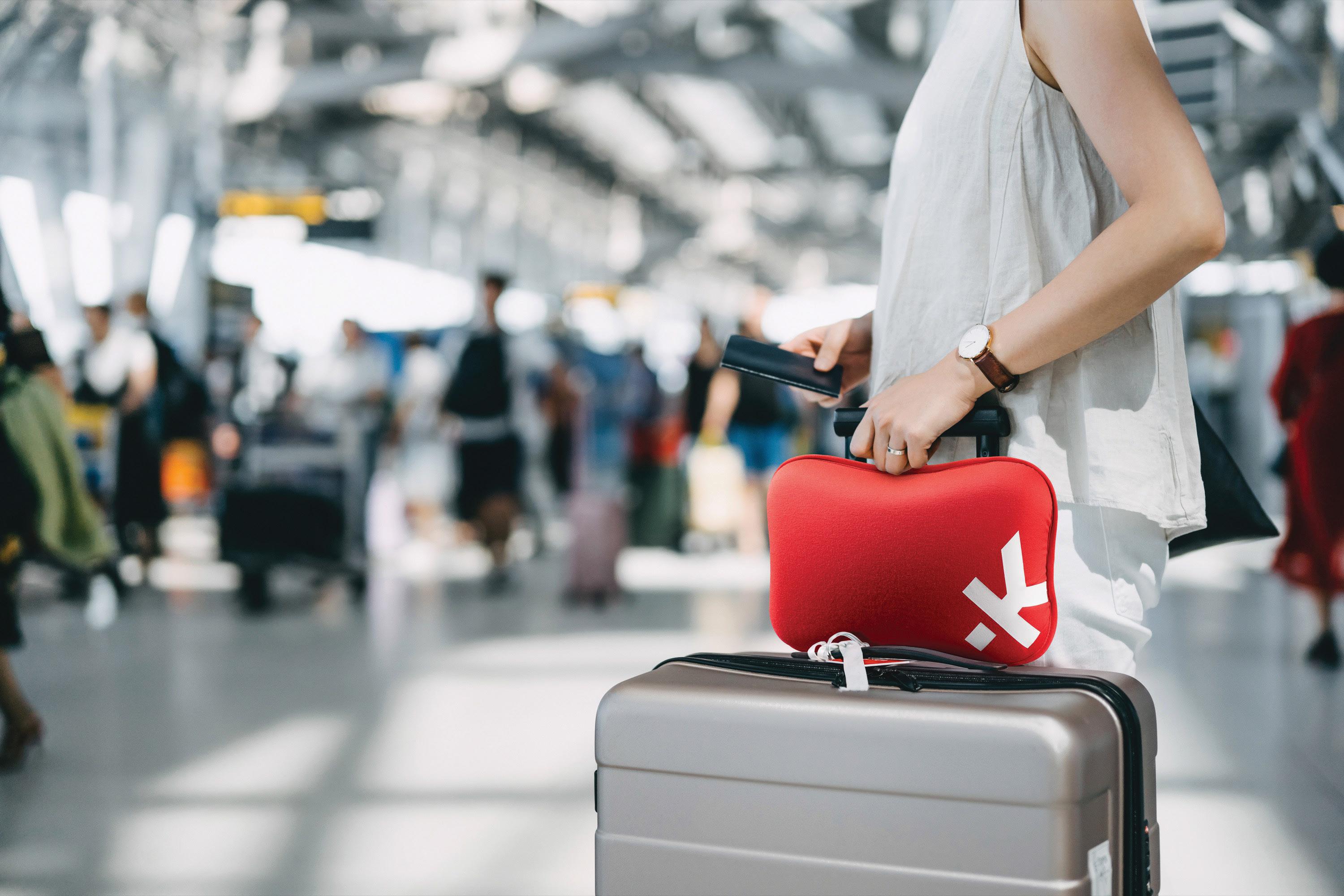











Travel retail fails when popular items become islands. One Red Kite’s Kevin Brocklebank suggests a new merchandising concept that can spell successby KEVIN BROCKLEBANK
When I was a child, I used to tag along on my grandparents’ weekly grocery shopping trip. They had a list, planned their meals and even took the weather into account when making their purchasing decisions. My mum did the same.
As time went by, mum’s shopping became less about re-stocking and more about individual shopping missions: Visit one might be to pick up bread, milk and other essentials, visit two might be to pick up the ingredients for a curry, visit three might be to pick up some tea, for example, and each trip held room for impulse purchases.
When supermarkets replaced local groceries, many thought this spelled doom for the smaller shops, but these shops found their niche and continued to thrive. Eventually, even the major supermarkets opened smaller “Express”
stores, seeing the need to provide for those quick shopping trips.
Mission-based retail
Mission-based retail, focusing on a specific reason for shopping, enables these small shops to offer customers the items they need. The shops don’t need to carry a huge range, as shoppers understand that the small stores cannot carry everything.
This type of shopping, for a specific reason, has made these stores hyper-relevant through effective range management, space planning and merchandising. No longer is the idea of merchandising to put the bread and milk at the very back of the store, making people walk past everything in the hope this will increase impulse sales.
Understanding the mission and merchandising accordingly is the way to success, and this is why you see all the

ingredients for a curry or a Thai meal within a short distance of each other.
So where does travel retail fail, why does it fail, and what can be done about it?
An archipelago is a group of islands, and this is a great analogy for the average travel retail store. Key brands are dotted around the store like islands, each island serving a specific customer desire. The customer selects that product, pays and leaves. Travel retail needs to build some





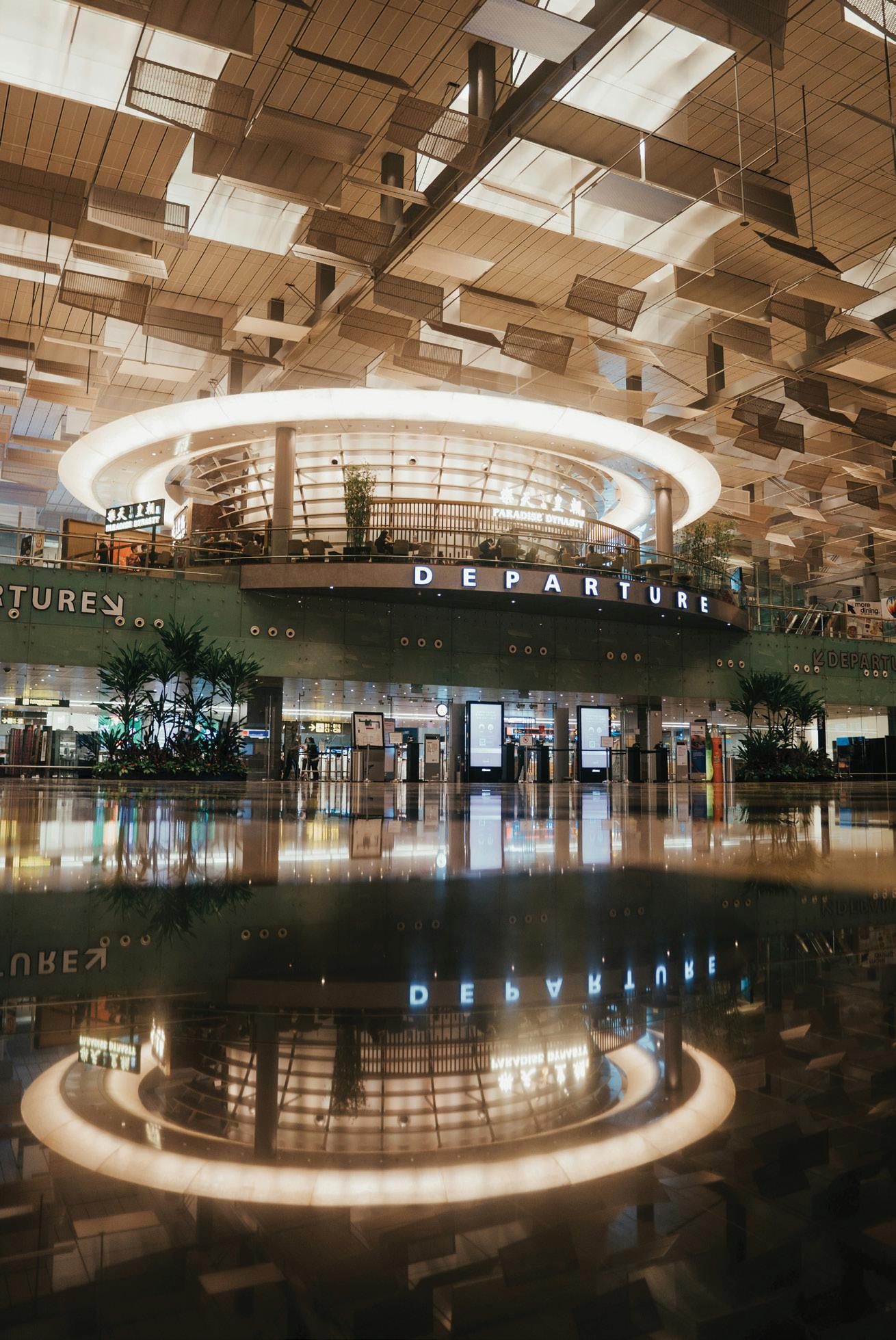
bridges to link these islands together.
Travel retail fails to capitalize on the opportunity that footfall brings; crosscategory and cross-brand purchasing is abysmal. When a customer plans to purchase a bottle of whisky, how can we effectively prompt them to also consider adding chocolates or a pair of sunglasses to their purchase?
When an airport experiences an influx of travelers heading to sunny holiday destinations, why isn't sunscreen displayed alongside sunglasses?
Introducing a bottle of Pimm's or an Aperol kit would complement the selection. For those airports frequented by party-goers, logic would suggest curating a selection that includes vodka, sunscreen, sunglasses, trendy makeup and fragrances together.
Swedish furniture store IKEA is excellent at bringing products to life through effective merchandising. Retail is rapidly becoming lifestyle oriented and products need to be presented in such a way to deliver concepts.
Brands from different categories do not come together and collaborate. They don’t share insights about their target audiences and explore ways of targeting those shoppers together.
And retailers are often too risk averse to try new things.
Some brands see other categories as competition, and that needs to stop. If they start seeing them as allies, it can help them push both towards growth. Tapping into another brand’s fanbase opens opportunities.
Retailers have powerful insights hidden within their data. It is relatively low cost to extract those insights using basket analysis — but it does require a fresh approach.
At One Red Kite, we're pioneering new frontiers beyond traditional basket analysis to uncover opportunities for retailers and brands. Our innovative strategies aim to secure a competitive edge for our clients, and the initial results are highly promising.
Kevin Brocklebank is the founder of the award-winning agency One Red Kite, which specializes in Data Management, Reporting and Analysis, and Category Projects. They work with some of the world's biggest brands to help them manage their data.
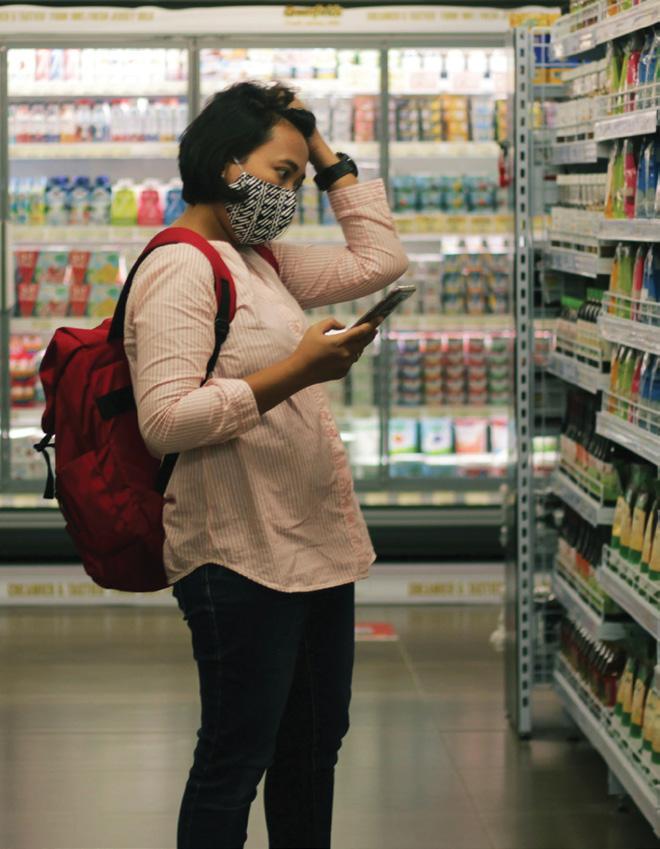
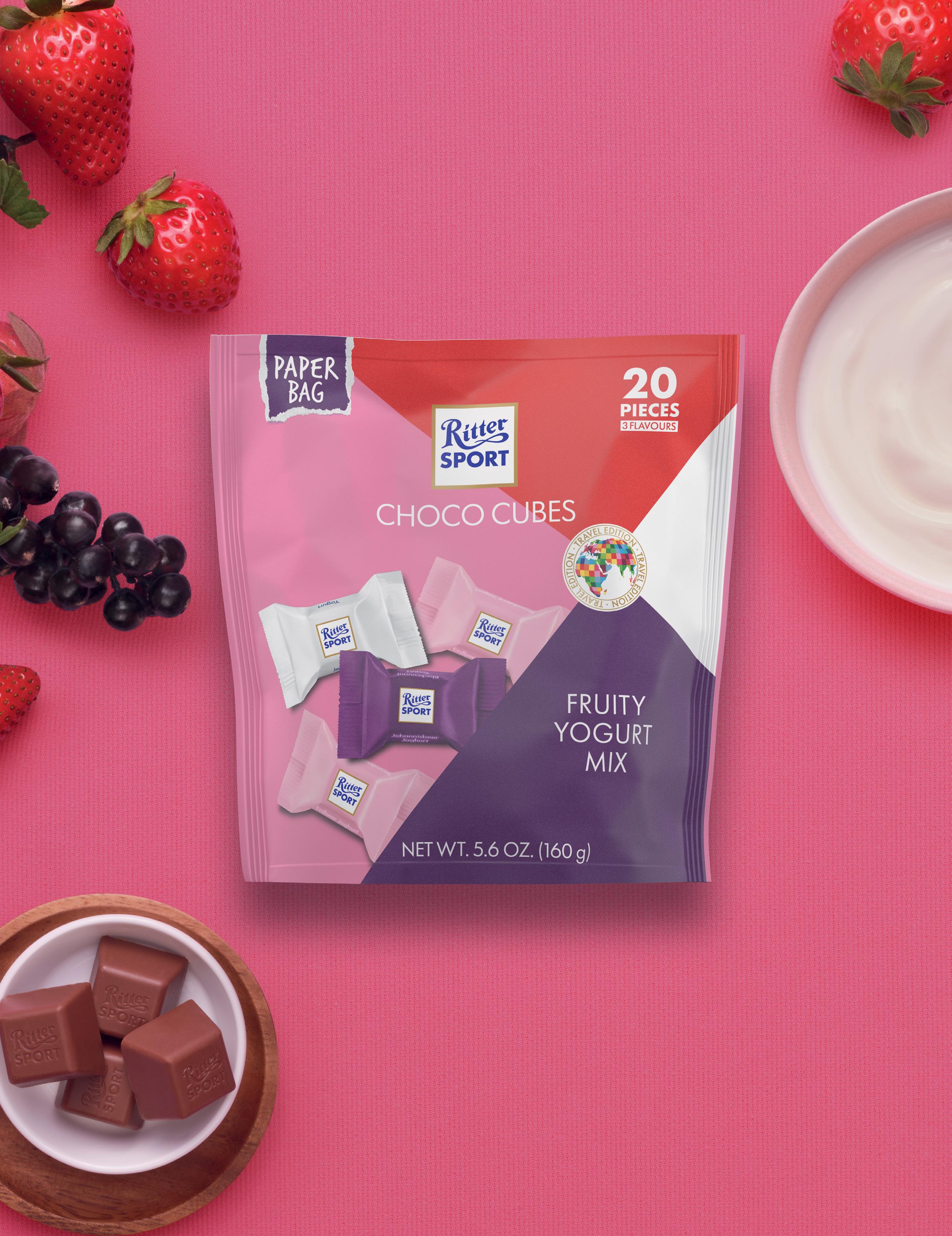

A look at Elizabeth Arden’s holistic approach to beauty and travel reveals more about its “Travel with Arden” campaign, travel pitstop concept at Changi Airport and skincare hacks for those on the moveby LAURA SHIRK
Seeing the opportunity to create portable, easy to carry products for women on the go, Elizabeth Arden developed the first travel-size beauty products more than a century ago. One year later, the brand became the first name in the cosmetics business to host a team of travel-

ing demonstrators and saleswomen.
Providing a quick history lesson, Joey Hoo, Marketing Director, Asia Pacific Travel Retail at the company, shares these early concepts pioneered by the founder and forward thinker are deeply rooted in the brand. “Elizabeth Arden products address various skin concerns

and the need for a beauty routine; the versatility of use and ease of carrying are also principles entrenched in our product development,” says Hoo. As noted by Hoo, the brand’s top three product ranges recommended for travelers on the go: Capsules serum range, Eight Hour Cream Skin Protectant and Prevage range (includes Prevage Anti-Aging Daily Serum 2.0 and Prevage City Smart Broad Spectrum SPF Hydrating Shield). The brand’s bestselling collection consists of seven different serum capsules that serve targeted skin solutions, packed and sealed in biodegradable and eco-friendly casings. Each capsule comes in a one-time dosage easy to use on the move.
Speaking about the best beauty hacks when it comes to travel, Hoo shares in addition to drinking water and staying hydrated, especially when experiencing harsh environments, frequent skin hydration helps to boost appearance. “We recommend the Eight Hour Miracle Hydrating Mist, which comes in a convenient TSA-friendly size spray bottle to spritz on anytime, anywhere. Powered by our superfruit
Elizabeth Arden’s travel pitstop at Changi Airport in partnership with The Shilla Duty Free is a one-stopshop for passengers to receive travel beauty tips and complimentary skin hydration services Elizabeth Arden Prevage Anti-Aging Daily Serum 2.0

blend, rich in antioxidants and vitamins, the mist instantly revitalizes the skin with a soothing touch of hydration. A great refresh companion for all types of weather conditions, it’s perfect to use on top of makeup or sun block,” he says.
“Travel with Arden” global campaign
The 2024 “Travel with Arden” brand campaign in collaboration with French artist Chloe Fleury, showcases paper constructed cityscapes and the Arden woman on her happy travels. “The use of famous international landmarks and the featuring of the Arden woman from different ethnic backgrounds mark the global diversity of ‘Travel with Arden.’ This holistic 360° campaign serves to animate the brand within travel retail with a focus on our bestselling travel essentials,” says Hoo.
Described as colorful, fun and attention-grabbing, the campaign visuals enable the brand to attract new consumers and promote its skincare travel hacks. According to Hoo, the company adapts the campaign locally and customizes its presentation and engagement strategy in order to best suit the demographic and consumer

base. “With our creative retailtainment twist, we aim to bring more smiles and happy memories to our customers, thereby fostering closer relationships with them,” he adds.
Travel pitstop at Changi Airport
Elaborating on the brand’s travel pitstop concept at Changi Airport and partnership with The Shilla Duty Free, Hoo calls the pop-up a one-stop-shop for passengers to receive travel beauty tips, complimentary skin hydration services and the chance to purchase Elizabeth Arden travel essential beauty products. Travelers are invited to benefit from an oxygen blast hydration boost featuring the brand’s hydrating mist, as well as hydration services via the self-service dispensing machines on-site. Visitors also receive a complimentary “Travel with Arden” travel journal; plus, shoppers who spend over US$50 are entitled to a collectible foldable shopping bag. Additional gifts are available for those who purchase at higher tiers.
“Singapore Changi Airport is an extremely important transit airport in Asia Pacific. With the ease of travel restrictions, the number of passengers traveling into Singapore has increased
The brand’s bestselling collection consists of different serum capsules that serve targeted skin solutions, packed and sealed in biodegradable and eco-friendly casings
by leaps and bounds, making Singapore the best location to debut this activation. By bringing our first travel pitstop concept to Changi Airport in partnership with Changi Airport Group and The Shilla Duty Free, we are able to showcase Elizabeth Arden’s unique services and travel-friendly beauty products to world class travelers in the region,” he explains.
The response to the travel pitstop at Changi Airport has been overwhelmingly positive. Hoo says those passing by are interested in testing the services available. As a result of increased interactive engagement, they also want to learn more about the brand’s products and travel beauty tips. It is evident that the concept is a successful tool for recruiting new customers.
“Through the ‘Travel with Arden’ campaign, we realized that customers are more willing to try new products and make purchases after receiving a service and beauty advice. We will continue to seek new ways to delight our customers with interactive experiences. We will also continue to innovate the campaign each year, such that there is always something new and exciting to look out for,” concludes Hoo.

In
this Skincare Report, experts at Blue Chip Group, Shiseido Travel Retail and Nuxe Travel Retail discuss skinimalism, multi-functional products and current category trends
by LAURA SHIRKKnown as the minimalistic approach to skincare “skinimalism” continues to trend across the beauty category in travel retail. However, the demand in line with this concept varies in Asia compared to Western countries. According to Flora Lee, Managing Director at Blue Chip Group, skincare is not limited to the physical application of products and basic products such as toner, cleanser and sunscreen are essential. She says so-called “inner beauty” units are performing well as a simple supplement in helping to boost the appearance of skin. Although this
is true, Lee reveals the first quarter of this year did not start on a high note for the global travel retailer, which specializes in perfumes, cosmetics, fashion and jewelry.
“The overall travel retail market is slow, and compared to 2023, still not picking up. One reason for this is the change in purchasing behavior among shoppers, as well as the economic situation in Asia – especially in China. As two major players, the Chinese market and the Korean market are still struggling. I expect the industry will shape up in 2025,” says Lee. The move away from traditional marketing is also prov-
ing to be difficult in some cases.
Speaking about the industry as a whole, Lee says brands are developing more at the low end of the price range with minimalistic colors and key skincare tools. “Consumers are choosing either ultra-luxury or practical skincare products; and regardless of the price point, skincare is now on the go,” she explains.
Blue Chip Group, an exclusive distributor of EviDenS De Beauté in Hong Kong and Macau, is opening additional stores in these locations soon. The brand will welcome outbound travelers with two new permanent counters at Shilla Beauty and You at Hong Kong International Airport in May. Additionally, EviDenS de Beauté will showcase its upscale pop-ups at the newly opened DFS store in Senado Square, Macau in July.
As shared by Lee, British fragrance brand Molton Brown and Japanese cosmetic brand Kanebo are also poised
Championing the “less is more” approach, Drunk Elephant focuses on active ingredients and healthy pH levels

to open stores at Hong Kong Airport. Starting in late May, passengers departing from the city will be able to explore a variety of unique fragrances from Molton Brown at Shilla Beauty and You, as well as discover eco-friendly skincare and makeup products from Kanebo.
Since the border reopening, the fastest and highest growing channel for the retailer has been inflight sales, which provides great potential in terms of travel retail sets. In collaboration with the group’s brands, Lee is interested in further exploring this market, as well as focusing on the development of practical products at an affordable price point.
Navigating the competitive skincare market, Shiseido Travel Retail (Shisiedo TR) embraces a holistic philosophy, combining the best of western science and eastern wisdom, as well as the bal-

ance between inner and outer beauty. Siv Chao, Vice President, Marketing, at the company, says this spirit guides its research and development, ensuring products address the root cause of concerns.
“Travelers today value wellbeing, authenticity and personalization. We address these needs by offering targeted solutions that prioritize skin health. Two of our brands, launched in travel retail in 2021, perfectly capture the essence of skinimalism,” explains Chao.
Championing the “less is more” approach, Drunk Elephant focuses on active ingredients and healthy pH levels. As noted by Chao, the brand's #barewithus social media movement displays the transformative power of this approach. It features real people experiencing healthier, more confident skin through a simplified routine. Separately, uber-luxe Japanese skincare brand THE GINZA, offers a tailored approach that
focuses on the skin's innate physiological functions to deliver a healthy glow in minimal steps.
In line with skinimalism, multifunctional products pair particularly well with travel. According to Chao, travel retail sets and exclusive ranges are central to the company’s strategy in Asia. “We understand travelers prioritize convenience and unique finds, especially in Asia, where limited edition products are highly sought-after. Our travel retail exclusive assortment focuses on core skincare needs for travelers on the go,” she shares. “We leverage market research to tailor sets by region, addressing specific Asian concerns. This ensures that we continue to create value for travelers and strengthen retailer partnerships.”
Echoing this sentiment, Caroline Goix, Global Sales & Marketing Manager at Nuxe Travel Retail, says the company is invested in providing a
tailor-made approach for each customer to find the product routine that best fits their skincare needs and simplifies their efforts. “Multi-purpose products have been at the heart of the brand since its founding more than 30 years ago with Huile Prodigieuse, a dry oil that ‘does it all’ for face, hair and body,” shares Coix. While on a mission to simplify skincare routines with the help of hero products such as its universal anti-aging concentrate Super Serum [10], Nuxe also keeps in mind the shoppers who want to buy multiple products to combat each of their specific skincare concerns.
Similar to Shiseido TR, Nuxe also adapts its travel retail exclusive assortment to suit shoppers in Asia Pacific. In the region, the company prioritizes this range using hero products, having duo packs of its Huile Prodigieuse and Rêve de Miel face and body routines. “We also focus on the sensoriality of our products and some of our travel products that are exclusive to APAC airlines such as Very Rose and Reve de Miel multi-care routines, which are more rituals-based and focus on the scent of the products,” says Coix.
Other notable trends in the region center on clean beauty and the rise of dermatological beauty brands. Similar to elsewhere in the world, Shiseido TR is seeing a surge in demand for natural and ethically sourced ingredients. Plus, consumers in Asia, specifically in China, are seeking evidence-based skincare with dermatologist-approved formulations.
“This focus on results aligns perfectly with Shiseido's heritage and research and development. We started out as a pharmaceutical company, so understanding the power of science-backed solutions for skin health is ingrained in our DNA. Asian travelers, known for being ingredient-savvy, actively seek potent ingredients with proven scientific backing and clinical efficacy,” says Chao.
Speaking about the ability to succeed in this market (and channel), Coix points out that the first step is to create truly effective products that deliver on their promise. She explains, “[Nuxe’s] brand credibility and appeal are based upon its proven unique expertise in creating effective formulations that are the result of a scientific approach that uses natural ingredients, sourced and manufactured responsibly.” The formulations are then infused with a seductive sensoriality and fragrance.
Coix continues, “Within the beauty category in travel retail there is definitely greater interest in skincare in Asia, compared to anywhere else. Within the segment, the most popular trend we are seeing is the increased demand for anti-aging products. Within the region, our business development continues to be built on two pillars: Huile Prodigieuse and antiaging products.”
Finally, post-pandemic Shiseido TR is seeing a shift in beauty consumption habits. Travelers are craving unique experiences and personalized services. Chao says they desire expert advice, in-store experiences and individualized consultations. At Sanya International Duty Free Shopping Complex Block C, it has opened the first-ever Clé de Peau Beauté Timeless Cabin. “Travelers are treated to a complimentary Touch of Radiance experience at the Radiance Lounge, exclusive to the Block C boutique,” she says. It is a customized 10-minute discovery of the brand’s iconic La Crème. A second example of the company’s personalized offering is its invite to discover the Japanese art of gifting via its signature Furoshiki service, which is available at flagship stores.

In Asia Pacific, Nuxe prioritizes its TREX range using hero products, having duo packs of its Huile Prodigieuse and Rêve de Miel face and body routines























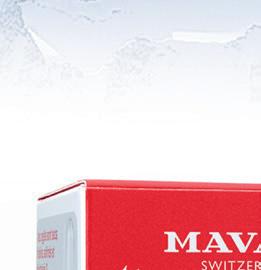












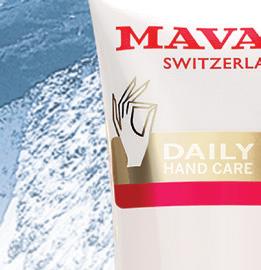






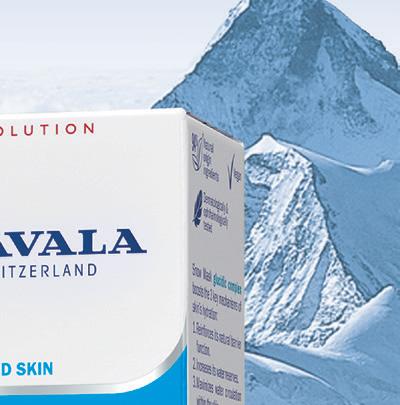





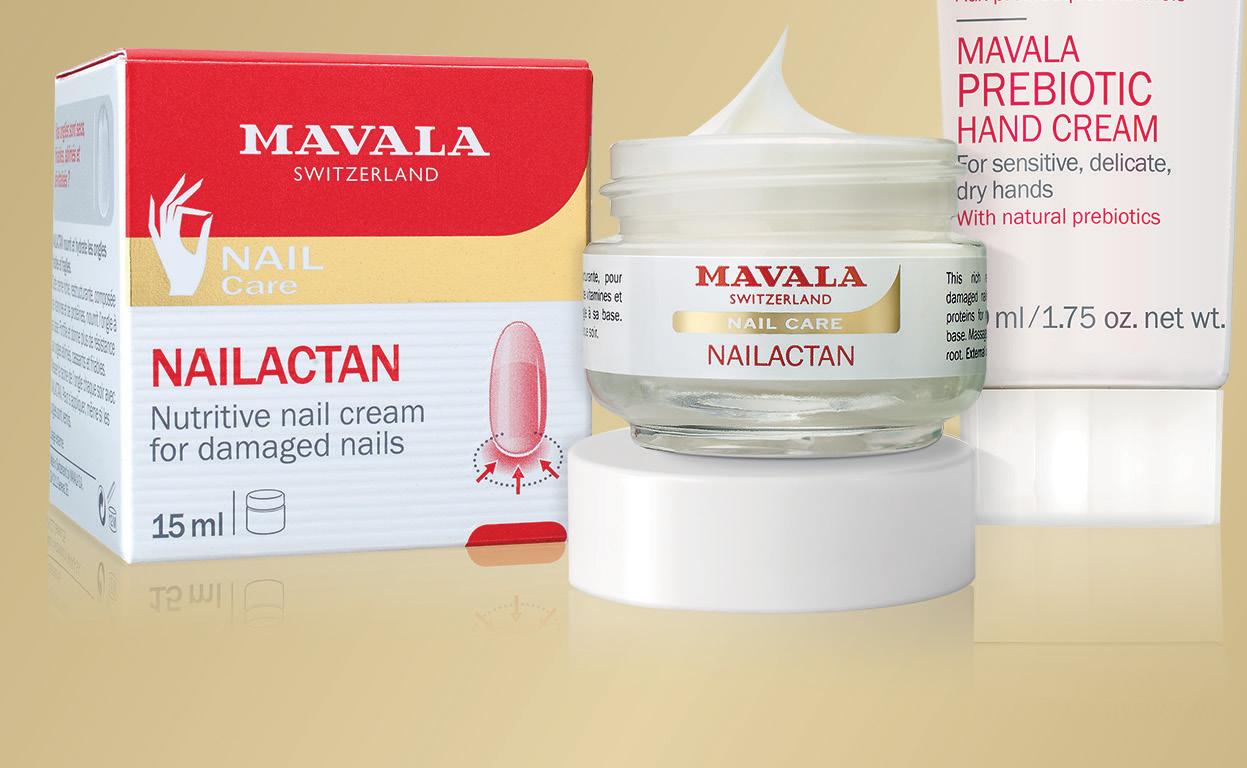







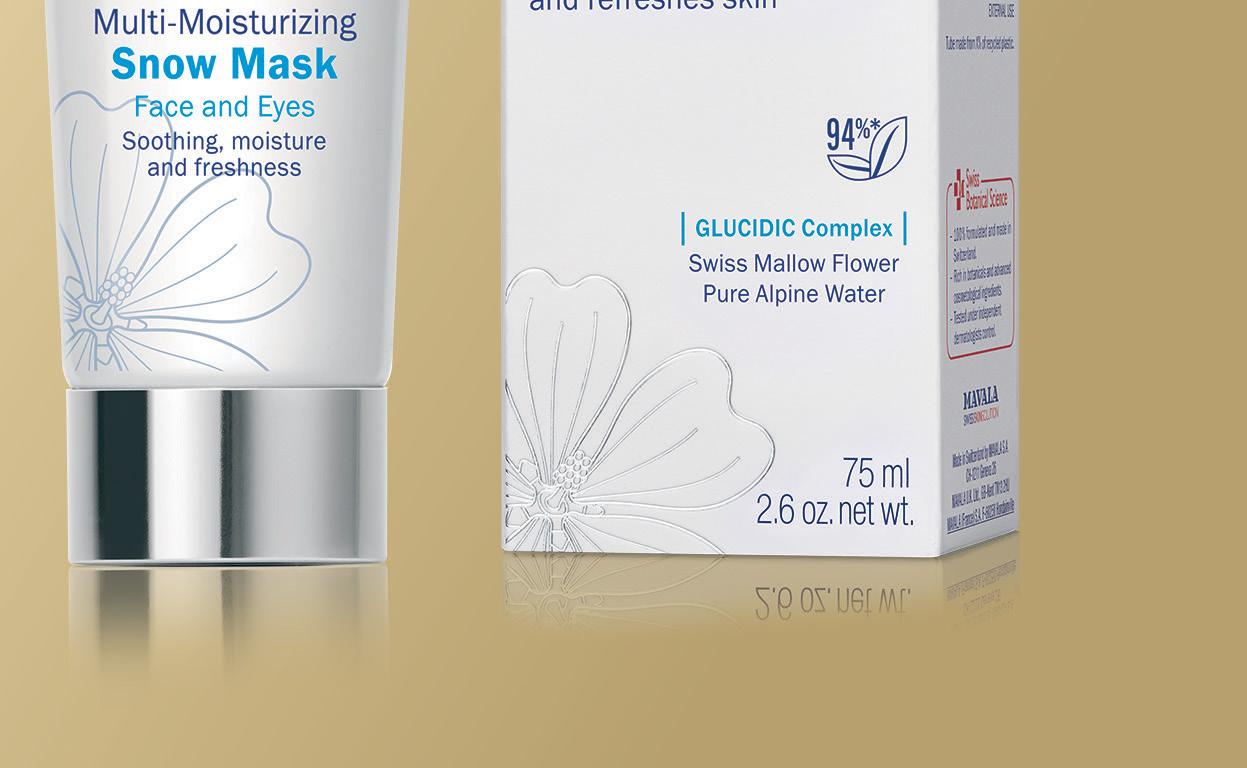









Premiumization in skincare is not going anywhere as brands continue to trade up, especially in China; while Asia Pacific is on the agenda for many beauty companies’ expansion plans, Global Travel Retail Magazine asks is C-Beauty a rising threat?
by ALISON FARRINGTONThe popularity of cross-border e-commerce is opening up a new path for C-beauty to go overseas, according to a market report by Jing Daily
While Chinese consumers continue to favor purchasing beauty products in domestic markets, the rise of digital platforms has made it easier for Chinese brands to reach Japanese and South Korean consumers who are increasingly happy to buy cosmetics on AliExpress and Temu at cheap prices, which could be a warning sign for global brands operating in China.
Coty tracks ‘promotionality’ in China
Coty looks to be watching the C-Beauty trend, or at least, how its advocates shop. China’s beauty brands are increasingly
competing with global giants in the country’s mass segment but the trend is not yet being seen in the prestige category, according to Coty CEO Sue Nabi. “The competition between international mass brands and local brands is fiercer than ever. And this is really a question mark for those who have big brands over there,” she shared during an earnings conference call in late 2023.
However, Nabi said that this phenomenon [C-Beauty] is currently contained mainly in the mass market segment, where Coty has a relatively small presence. “Regarding prestige and skincare markets, we don’t see this yet. There is a kind of cohabitation between local new players, specifically in the niche market. I wouldn’t say that I see this phenomenon happening in this part,” she explained.

The trend for trading down in China is because of the ‘promotionality’ of the market. Nabi added, “It’s not people moving from an expensive brand to the least expensive brand, it’s people looking for promotions to buy at a cheaper cost.”
China’s luxury beauty market is still strong and remains “very resilient in the higher end of the market.”
Elizabeth Arden’s Prevage Anti-Aging Intensive Serum is a growth pillar for China





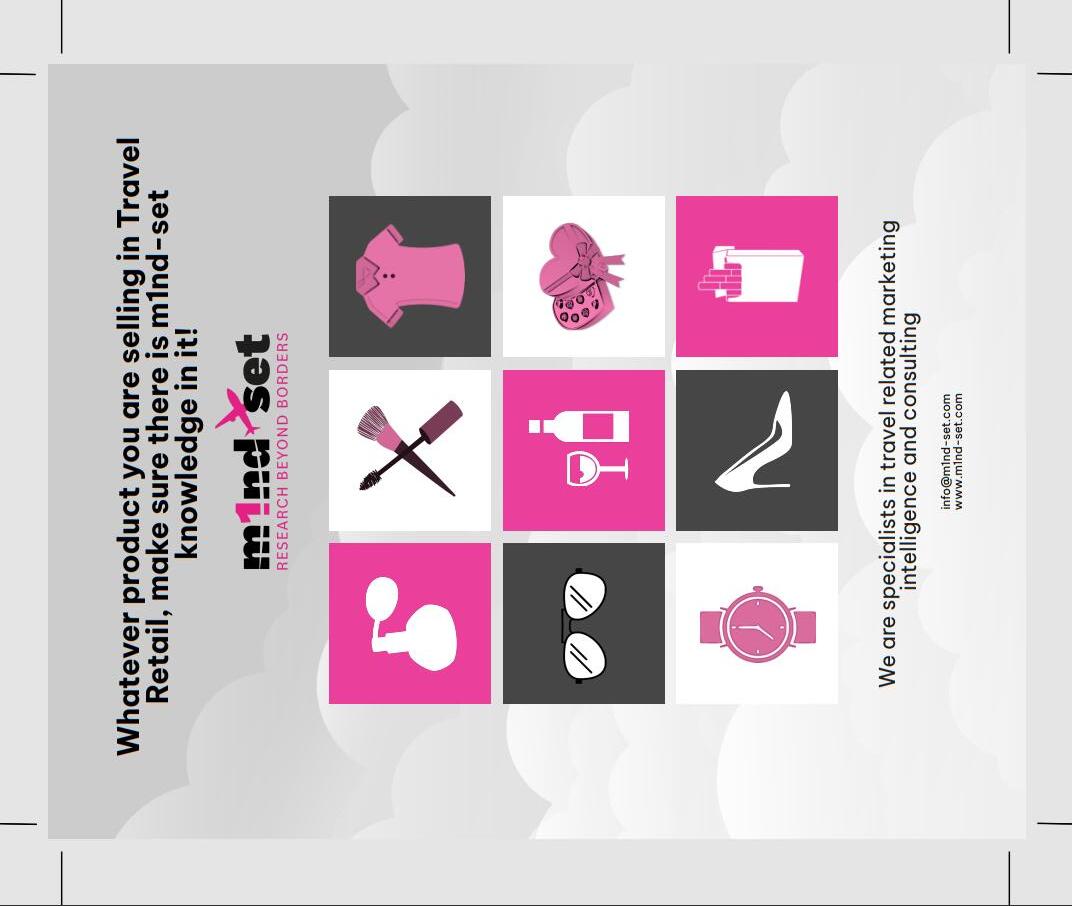





To celebrate International Women’s Day, SK-II launched a campaign that chronicled the transformation journey of five women as they learned to embrace their bare skin and true selves as they age
Beauty brands look to premiumize
Market research firm, McKinsey, forecasts that premiumization in skincare remains untapped and offers potential growth since affluent customers prefer premium over mass-market brands. It suggests the premium beauty tier is projected to grow at an annual rate of 8% (compared to 5% in mass beauty) between 2022 and 2027, as consumers increase their spending.
International beauty conglomerates such as L'Oréal and Coty continue to see China as a growth engine. L'Oréal has recently launched Prada's beauty business in China, while Coty is focusing on the Chinese market for its new ultrahigh-end skincare lines: Orveda and Lancaster’s Ligne Princière.
L’Oréal’s beauty tech focus
At its TFWA Cannes 2023 showcase, L’Oréal Travel Retail Dermocosmetics & Professional Products Divisions General Manager Anne-Laure Lecerf highlighted how the Skinceuticals salonstyle concept represents the company’s
commitment to its dermocosmetics division, which is outperforming the overall skincare market, and is primed for expansion in travel retail.
It’s a China-first strategy for the brand’s roll out. To kick off, the SkinCeuticals A.G.E. Interrupter Lab, was launched in Haitang Bay, Hainan, as a pop-up in partnership with China Duty Free Group in May 2023. The activation showcased the brand’s anti-aging innovation, Advanced Skinscope, which effectively brings a medical-grade diagnostic service to travelers.
For Revlon-owned Elizabeth Arden, China is once again a target for the brand’s travel retail growth plans. Its two prestige skincare pillars, Ceremides and Prevage, are the focus of its promotional activity for 2024, according to Yumie Chia, General Manager for Asia Pacific Travel Retail, who told Cosmetics Design Asia both brands delivered a strong “double digit growth” performance in 2023.
To underscore the brand’s commitment to China, in December last year, Elizabeth Arden partnered with CDFG to host a VIP event in Hainan to ensure the brand’s core attributes of strength and positivity were communicated via
selected KOLs for its Chinese customers on the resort island. At the time, Chia commented, “Our brand founder, Elizabeth Arden, is a power woman of her times. Similarly, Elizabeth Arden products, especially Prevage, instill strength and positivity. We wish to bring such motivating messages to our customers.” The event featured a Prevage themed high tea; beauty masterclass; self-growth talk on building one’s inner strength, as well as DIY grooming activities.
Tailoring its products to Chinese consumers looks to be a strategic decision for SK-II. To celebrate International Women’s Day in March, the Korean brand launched an ad campaign, “More Youthful With Age #越大越不 ZHUANG” that chronicled the transformation journey of five women as they learned to embrace their bare skin and true selves as they age.
The campaign went viral and sparked passionate discussion on social media about how women are expected to look as they grow older. The slogan and concept of “ZHUANG”, meaning both to mask by ‘putting on a front’ and ‘putting on your face (with makeup)”, aligns with the brand’s purpose to give women courage to choose their own destiny being in skin or in life.
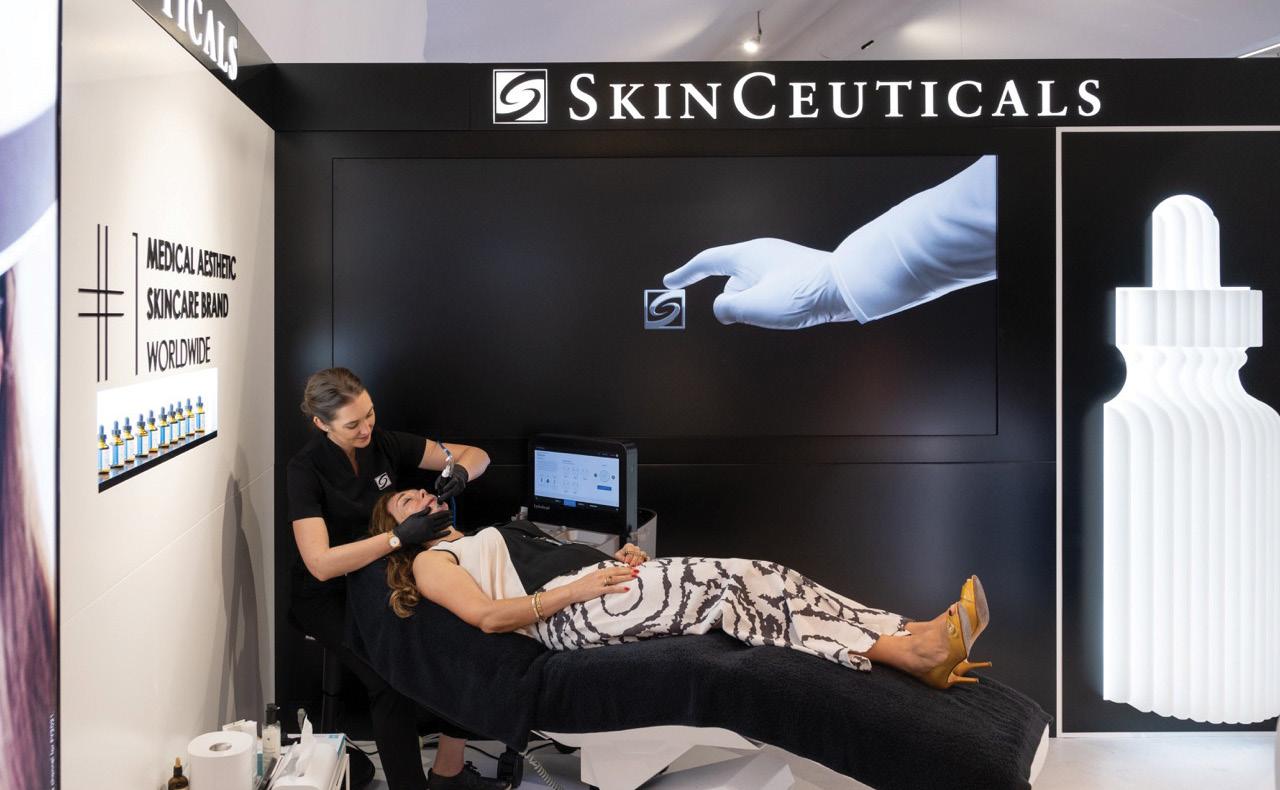

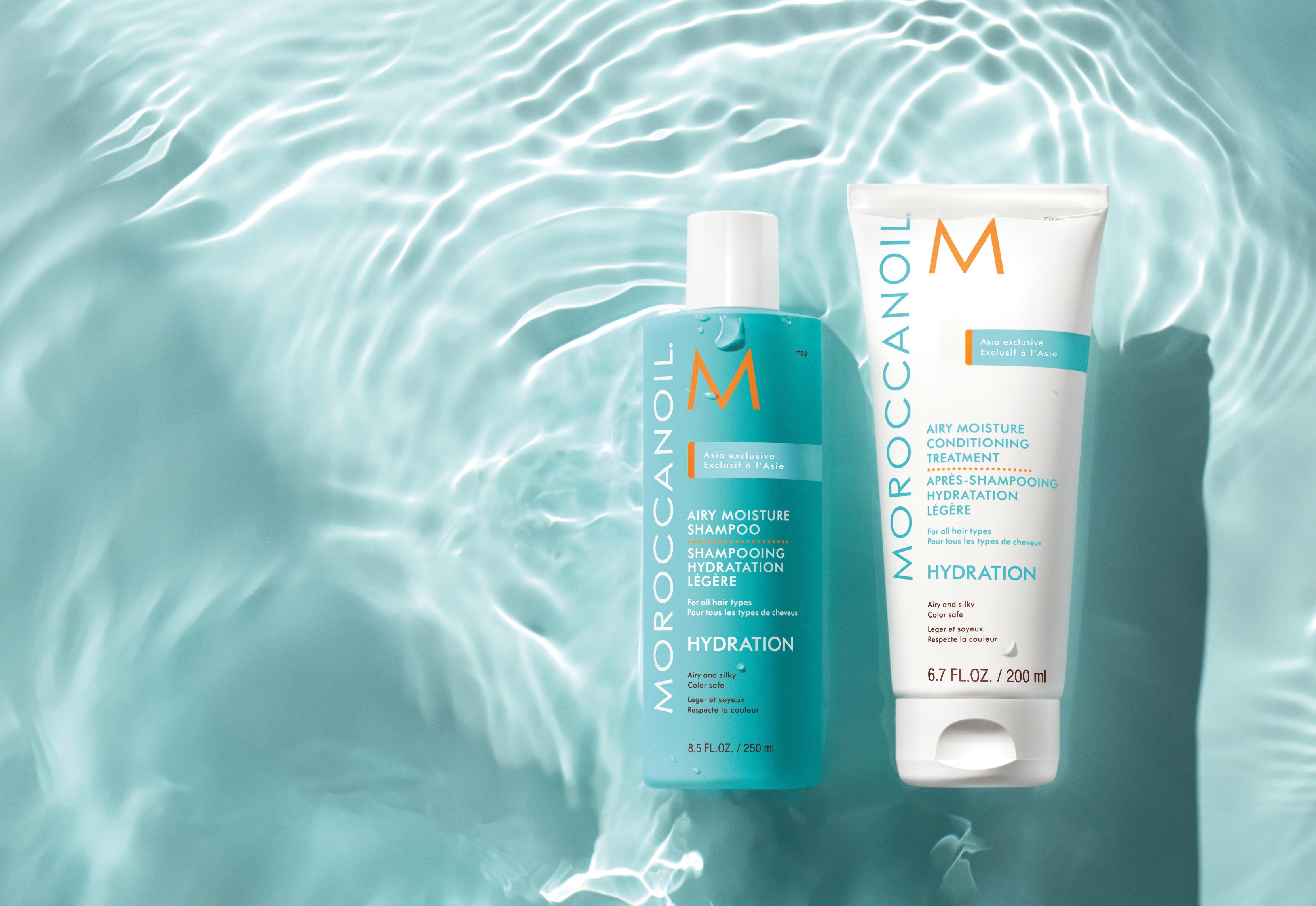
Solidifying its footprint in Asia, Moroccanoil’s Airy Moisture is expected to become a major pillar of the brand in the region; plus, Vice President Global Travel Retail Sebastien Levi talks travel retail sets, APAC openings and more
by LAURA SHIRKHaving previously returned to pre-pandemic levels in Europe and the Americas, leading beauty brand Moroccanoil expects to see the same results in Asia by the end of this year. According to Sebastien Levi, Vice President Global Travel Retail at the company, Moroccanoil’s growth in the first quarter of 2024 exceeded expectations and ranked higher than in recent years (the brand experienced triple-digit growth in Q1 2023 vs. Q1 2022). Levi says this can be explained by the release of its haircare line Airy Moisture, in
addition to the strong performance of its travel retail sets and their introduction into new locations including Sydney, Australia, with Gebr. Heinemann, and expansion at Hong Kong and Singapore airports with The Shilla Duty Free.
Airy Moisture: haircare line and brand pillar
With a focus on expanding its presence in Asia, as well as entering the Chinese market, the launch of Airy Moisture last year served as Moroccanoil’s first regional development. When asked about the consumer response and how
the company will promote this strategic move in 2024, Levi says the release has solidified its footprint in Asia and helped to increase awareness, sales and repeat purchases. The brand intends to further develop the franchise this year, with related sets, promotions and events. “Airy Moisture is truly expected to become a major pillar of the brand in Asia, and the initial response by consumers proves this ambition to be correct. The launch comes at the best possible time in travel retail; as the channel bounces back in the region, Asian passengers are starting to return to Europe and America,” says Levi.
Consisting of an exclusive formula, the range has been crafted with local hair needs in mind.
The introduction of the brand at Sephora in China also represents a milestone for Moroccanoil. This move will lead to greater travel retail opportunities in the region, mainly in mainland China
Moroccanoil’s growth in the first quarter of 2024 ranked higher than in recent years (the brand experienced triple-digit growth in Q1 2023 vs. Q1 2022)


and Hainan. Airy Moisture is considered a major element to capitalize on the brand’s consumer base there.
Travel retail sets and APAC openings
Discussing travel retail sets and exclusive lines, Levi notes that the brand’s focus on sets is not limited to Asia – it is a priority worldwide. “This is a way for us to bring differentiation and offer a taste of the brand through passengers’ routine. One specificity in Asia travel retail is that we also have sets with fullsize products, which we have less of in Europe. This offers added value to our consumers in the channel, and this is something we intend to continue and reinforce in the years to come,” he explains.
Levi also points out that travel sets provide an opportunity to “bring hair and body under one roof,” which is a message that is consistent with the brand’s strategy to be recognized as not
only a hair care brand, but a lifestyle beauty brand.
In the last several months, Moroccanoil has conducted a number of major openings in Asia Pacific including in Hainan with Hainan Tourism Duty Free; Taipei, Taiwan, with Ever Rich Duty Free; and Kansai, Japan, with Lagardère Travel Retail. Generally, the brand has been capitalizing on the self-care trend, with major gains in market share across the region. “With the expanding of our travel sets, we have been able to increase personalization at the point of sale, conveying our strong brand identity in the channel,” shares Levi. “We look forward to strengthening even further our partnerships in travel retail, offering additional services and seizing opportunities such as brushes. The introduction of these so far at select locations has been positive.”
Shifting from retailers to airlines, Moroccanoil emphasizes that inflight business remains key to its overall
travel retail vision, especially in Asia where it continues to be a major force. Early on, inflight business served as the number one channel in travel retail for the brand. The company is proud of its presence onboard the catalogues of prestigious airlines including Cathay Pacific, Japan Airlines, Malaysia Airlines and Korean Airlines and looks forward to also strengthening these partnerships in the future.
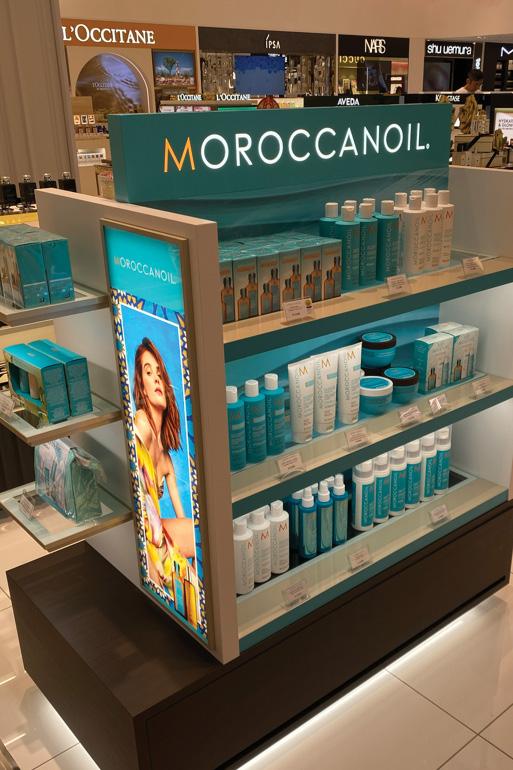 Sebastien Levi at Moroccanoil says travel sets provide an opportunity to “bring hair and body under one roof,” which is a message that is consistent with the brand’s strategy
Sebastien Levi at Moroccanoil says travel sets provide an opportunity to “bring hair and body under one roof,” which is a message that is consistent with the brand’s strategy
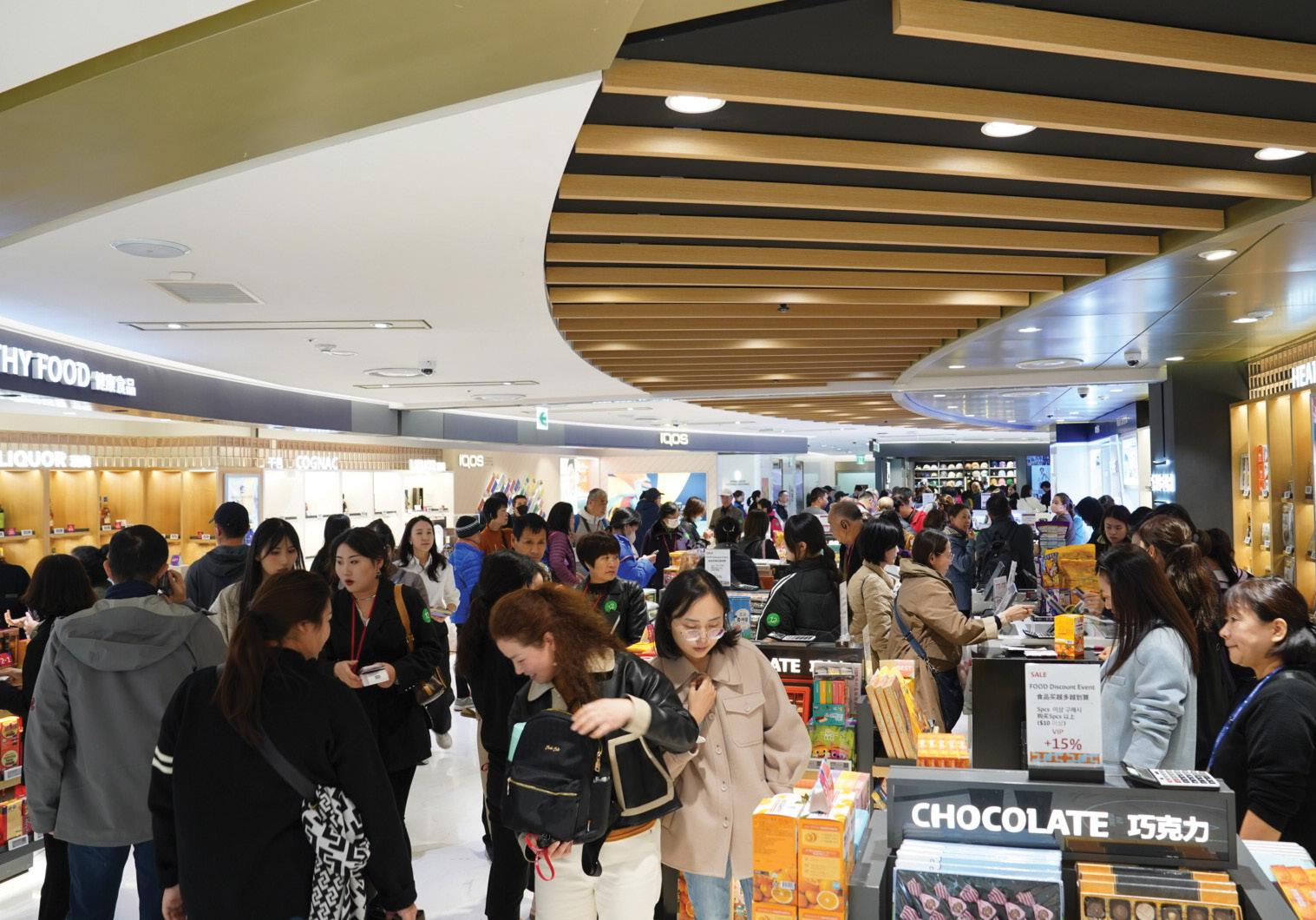
Global Travel Retail Magazine explores the nuances of Asia’s duty free confectionery landscape with some of the region’s top retailers as they commandeer shifting trends, digital innovations and pet-friendly initiatives, readying delights for global travelers
by WENDY MORLEYIn travel retail, where global journeys intersect with diverse consumer appetites, the confectionery category stands out as a beacon of delight and exploration. As travelers experience the diverse landscapes of the largest continent, retailers must steer through shifting consumer trends to provide the optimal indulgent experiences for discerning global travelers.
Consumer preferences are evolving towards quality and value, as Sophie
Park, Confectionery Buyer at Lotte Duty Free attests, “Consumers are increasingly willing to pay more for good quality products, even if they are more expensive.”
She notes a noticeable inclination towards premium products, with travelers favoring superior ingredients and packaging like artisanal coffee and luxury chocolates over traditional bulk gifts. Lotte is adapting to this trend by expanding its range of high-end brands, recognizing the potential for growth in the luxury segment.

Similarly, Heinemann Asia Pacific is capitalizing on the surge in demand for local and culturally resonant products, enhancing the travel retail experience by integrating local flavors and collaborating with indigenous brands. Ranjith Menon, Purchasing Director (Beauty and Liquor, Tobacco & Confectionery) at Heinemann Asia Pacific highlights this approach, “By integrating local flavors and collaborating with local brands, we’re not just selling confectionery; we’re offering a piece of local heritage.”
Lotte consumers are willing to pay more for good quality products. This is Lotte’s Duty Free’s main store in Myeongdong on the ninth floor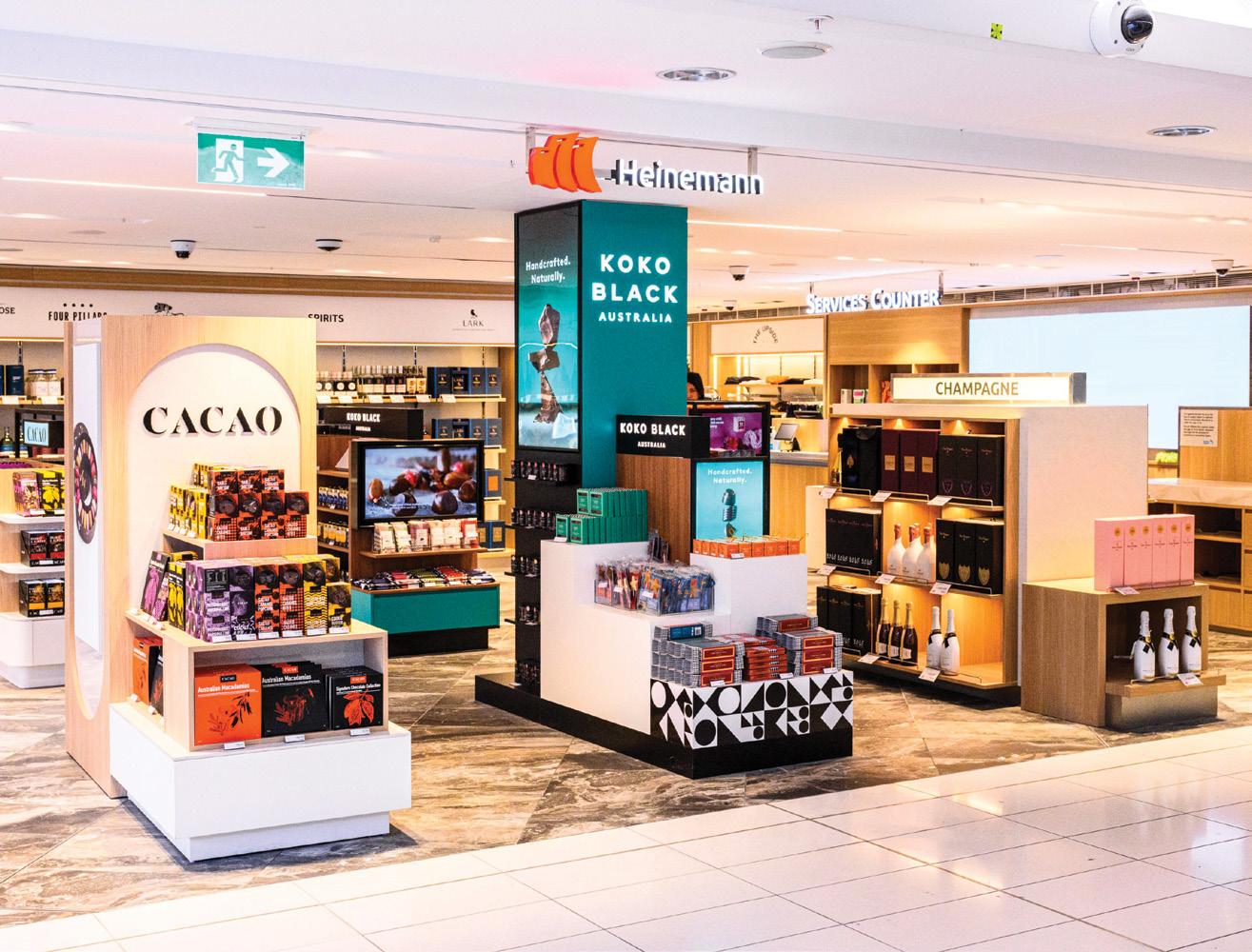
With the growing interest in health and wellness, there has been an increase in demand for low-calorie foods and products with fewer additives. Park emphasizes the importance of keywords such as “zero sugar,” “natural,” “lowcalorie,” and “nuts.” Lotte Duty Free is actively working to strengthen its lineup of these options, anticipating further growth in market size and sales in the coming year. Park says, “Candies, chocolates and processed foods made with healthy ingredients such as red ginseng and ginseng are becoming increasingly popular.”
Menon also sees the impact of the health and wellness trend, stating, “The growing consumer focus on health and wellness has had a notable impact on the confectionery product range.” He notes the industry’s efforts to diversify product offerings with healthier options while still catering to indulgent tastes with initiatives such as increasing the availability of organic and natural products and prioritizing transparent and informative labeling to meet the demands of health-conscious travelers.
This trend is helpful in navigating increased regulations. Menon empha-
sizes the importance of adaptation, “It’s about seizing the opportunity to innovate and cater to the health-conscious consumer.” This includes shifts towards transparency in ingredient sourcing, reduced sugar content and the inclusion of healthier alternatives.
Lotte Duty Free is harnessing the power of social media and digital technology to revolutionize the marketing and sale of confectionery products within the travel retail sector. As the global appetite
for K-FOOD soars, propelled by the growing popularity of Korean culture, Lotte Duty Free is strategically positioning its confectionery offerings to meet this rising demand.
Lotte is offering personalized shopping suggestions based on customers’ purchase and product search histories in its online store. It utilizes data analytics to refine the shopping experience, presenting customers with customized product recommendations that align with their preferences, a technique that has proven successful. This commitment to digital innovation underscores the retailer’s efforts to stay on top of trends and cater to the evolving tastes of its global customer base.
At Changi Airport, the allure of confectionery remains strong, consistently ranking among the best-selling categories for its convenience as a last-minute gift option for those embarking on journeys, Gwyn Sin, Vice President of Airside Concessions at Changi Airport Group notes, “In the last quarter of 2023, passengers from India, China and Singapore were the top buyers in this category.”
Changi Airport Group is dedicated to enhancing the customer experience, working with retailers to introduce creative methods to draw in more patrons
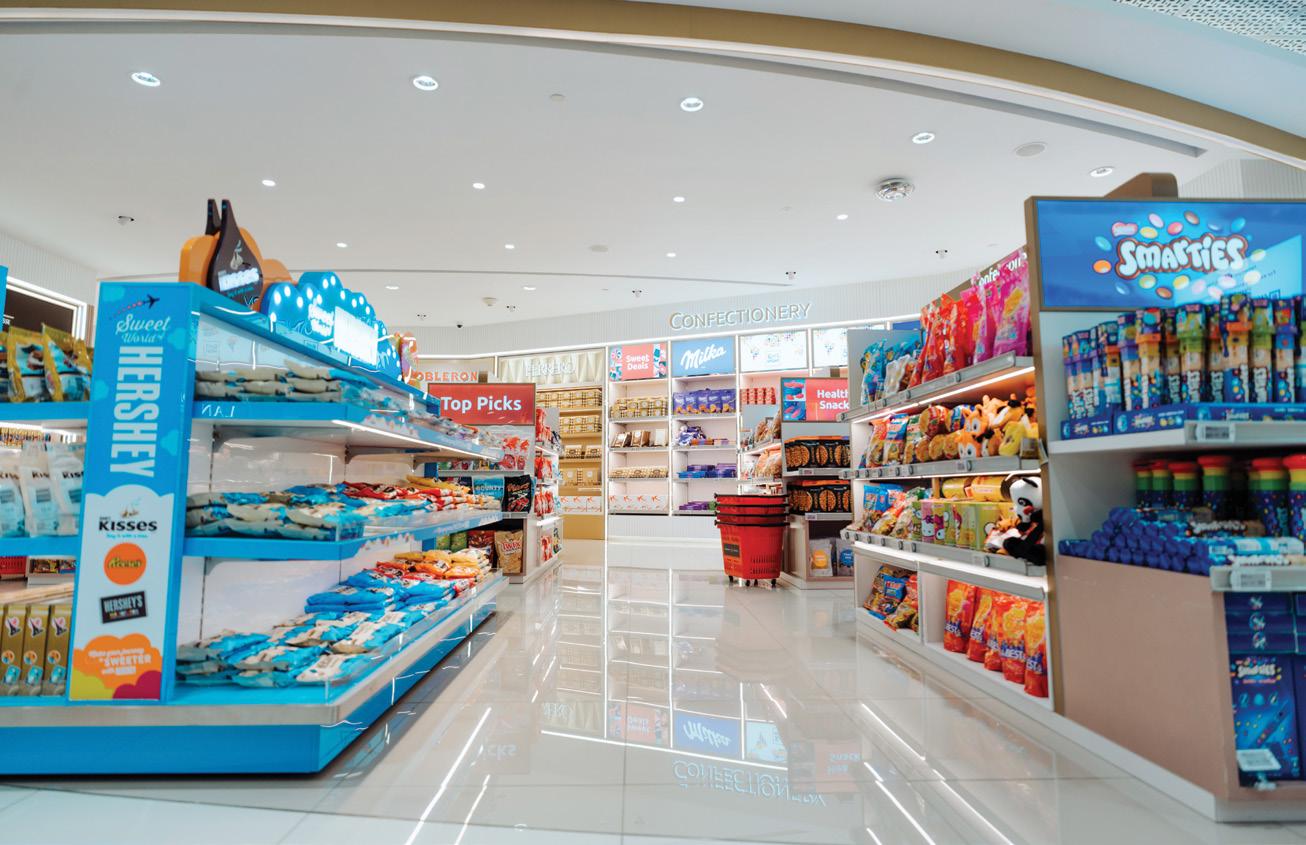
and boost retail sales through engaging, airport-wide initiatives.
In the face of global inflation, Lotte Duty Free’s approach to mitigate consumer impact is to minimize price increases through consultation with brands, aiming to reduce the burden on consumers.
Heinemann Asia Pacific adopts various strategies, including pricing adjustments and cost optimization, to meet consumer expectations. Both retailers emphasize strategic pricing and cost management to balance operational sustainability and consumer affordability amidst inflation in the duty free confectionery market.
Lotte Duty Free is noting a remarkable upswing in a niche market often overlooked in duty free retail: pet-related products, specifically within the confectionery and food category. This trend correlates with the increasing number of single-person households and the concurrent rise in pet ownership. Pet
food is expected to occupy a growing share of the food category’s sales at Lotte Duty Free, indicating that high-quality pet nutrition is not just a passing trend but a significant and growing sector in travel retail. “There is distinct growth in the market for pet-related products in in the duty free shop’s confectionery and food category,” Park says.
The statistics are telling; sales of pet food and treats at Lotte Duty Free surged nearly fivefold in 2023 compared to the previous year. This spike reflects a broader market evolution, with global pet care expanding and the industry responding with specialized offerings such as organic and special diet pet foods.
FNA Group International is actively collaborating with suppliers to broaden its product offerings, focusing on the introduction of limited-edition gift packs and locally designed packaging tailored to seasonal occasions such as Lunar New Year, Valentine’s Day, Hari Raya, Easter, Diwali and Christmas.
Pamela Loo, Director of Retail and
Local Sales at FNA Group International, emphasizes the company’s commitment to enhancing the shopping experience through exclusive offerings. “We developed ‘The Cocoa Trees’ gift boxes and bags, providing customers with the opportunity to curate their own selection of products,” states Loo. “These unique offerings are available exclusively at the Terminal 2 [Changi] main store, which opened in October last year.”
Heinemann Asia Pacific is employing innovative strategies to optimize its confectionery spaces, focusing on creating an engaging shopping environment that resonates with the desires of modern travelers.
“Optimizing our confectionery space is about more than just efficient product placement; it’s about creating experiences that captivate our customers,” Menon says. “Through strategic zoning, engaging digital interfaces, and personalized cross-promotions, we’re elevating the shopping experience to meet the expectations of today’s discerning travelers.”







COME DISCOVER OUR PRODUCTS AT THE TFWA ASIA PACIFIC EXHIBITION
Basement 2 - booth H26


Global confectionery companies Mars, Mondelēz and Nestlé are leveraging regional festivities and cultural nuances to enhance brand relevance and drive sales in the dynamic Asia Pacific market
by WENDY MORLEYThe integration of festive traditions and a diverse cultural landscape plays a significant role in the growth of the confectionery market in the Asia Pacific region. Beatriz De Otto, Head of Customer Marketing at Mondelēz World Travel Retail (Mondelēz WTR), says, “Integrating festive traditions and cultural diversity is not just a strategic component – it’s deeply embedded in our mindset and business approach.” Last November, Mondelēz launched special Toblerone sleeves for Diwali in Singapore and Thailand and for Chinese New Year across major Asian airports. De Otto says, “These vibrant designs appeal to customers seeking unique souvenirs or thoughtful gifts, driving both penetration and conversion within the category.”
In line with this thinking, Marcus
Hudson, Global Sales Director at Mars International Travel Retail, acknowledges the importance of respecting cultural diversity in the company’s operational strategy, especially in travel retail. “We are highly aware of the importance of cultural traditions in the diverse cultural landscape we are operating in,” Hudson notes, adding that Mars ensures its global brands like M&Ms maintain regional relevance. “In Asia, we do this very clearly in our execution. We are clear, and becoming more convinced, that one size does not fit all,” he says.
Nestlé is committed to tailoring marketing activities and strategies to meet different cultural preferences and festive traditions, according to Aura Sanchez, Global Head of Marketing at Nestlé International Travel
Retail (NITR). She details how NITR’s strategy includes special packaging and limited editions for events like Chinese New Year, Diwali and Ramadan. “Digital communication in key Asia Pacific airports is vital to reach our key shopper nationalities,” she says.
As consumer preferences evolve toward healthier and more convenient options, companies in the confectionery category are actively adapting their offerings to align with these trends in the Asia Pacific region.
“Like much of the world, shoppers in Asia are increasingly pursuing a healthy lifestyle and are becoming more concerned about the function of a product and the ingredients that go into it,” shares Sanchez. Nestlé is responding by developing functional products and sourcing materials that are sustainable and organic. Sanchez reveals the company’s strategic focus on expanding its consumer care brands, such as Solgar, into Asia Pacific travel retail is driven
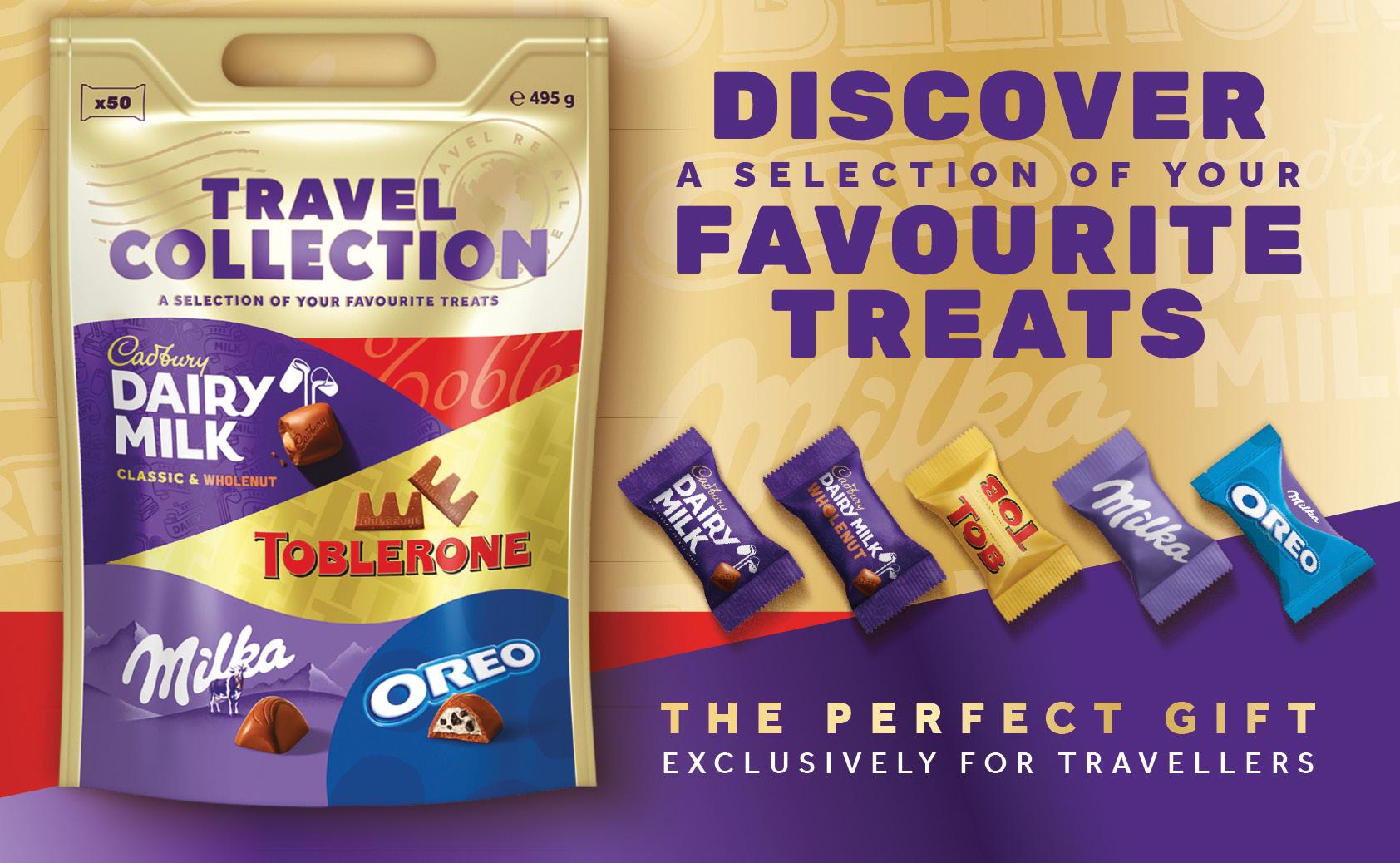
by research indicating a significant demand for health and wellness products among travelers.
As a reflection of changing snacking habits, De Otto highlights the growing preference for bite-size confectionery.
“Snacking culture has evolved in the confectionery category,” she says. “We create sharing packs that feature individually wrapped, smaller items of some of our most popular brands.”
Understanding and integrating cultural significance and regional specificities is critical for confectionery companies operating in the diverse Asia Pacific market. For Mondelēz WTR, personalization through localization is a key strategy. De Otto explains how Mondelēz leverages cultural events and local flavors to connect with consumers. “An example of this is the Toblerone Diwali HPPs, which were rolled out last year in high-profile areas at airports in both Singapore and Thailand,” she says.
Hudson emphasizes the importance of tailoring product offerings to meet varied demands across different regions.
“Cultural significance is embedded within elements of our portfolio,” he points out, adding that the company capitalizes on regional strengths to
enhance market presence. “Galaxy is a global brand, but in the Middle East it is a market-leading brand. We leverage this heavily on the shop floor, as can be seen with our recent Ramadan activations,” he adds.
Nestlé “always” tailors its assortment to the consumer needs of the region and country, according to Sanchez. “For example, there have been more than 300 limited edition seasonal and regional flavors of KitKat chocolate bars produced in Japan since 2000, many exclusive to the country,” she says.
The next wave
As global consumers increasingly turn to e-commerce platforms and digital services, confectionery companies are exploring innovative ways to meet these evolving demands through personalization and technology. “Within the future communication of our brands in airports, digital and gamification will be a core element,” says Hudson. “We have a job to do, especially in Asia, to ensure that our physical in-store availability and execution is perfect, entertaining and exciting – this will be the key to driving conversion.”
“The exciting aspect of technology is the potential it holds to revolutionize our industry,” says De Otto. She outlines
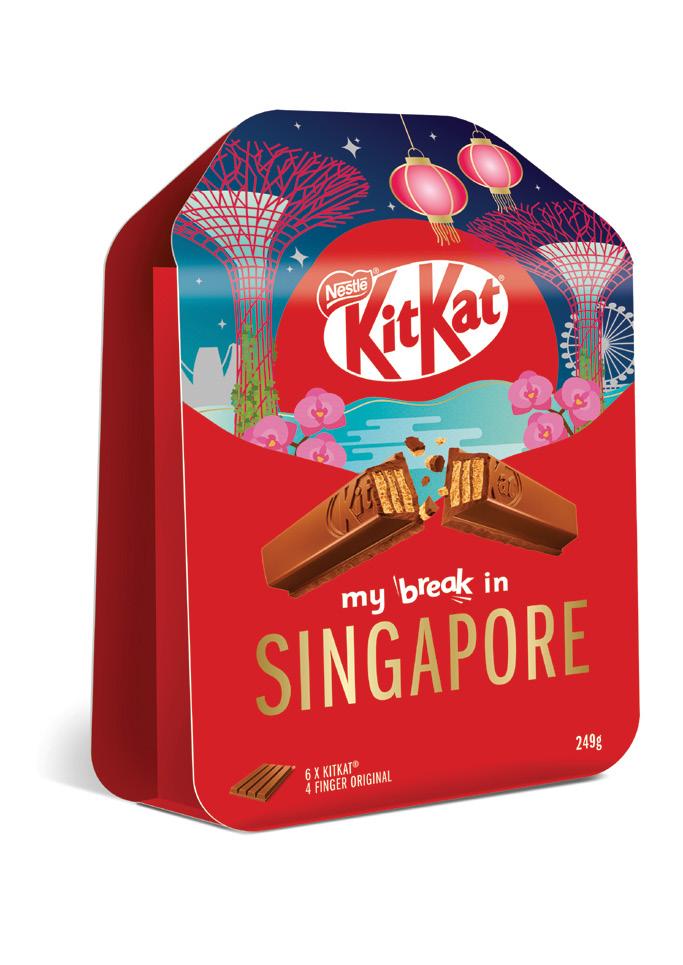
several hugely successful innovative uses of technology at Mondelēz. Two examples are the Toblerone sleeve printers that allow consumers to customize sleeves by adding text and images, and the Cadbury Laser Etched Bar, which was a limited edition product etched with intricate designs.
On the topic, Sanchez highlights the Smarties Cool Creatures launch, which combines physical products with digital experiences. “The set allows children to scan an on-pack QR code to access a colorful, interactive virtual world.” She also mentions NITR’s strategic use of Dynamic Creative Optimization. It is a technology-driven advertising approach that allows for the real-time customization and optimization of digital ad creative elements based on various data signals.
The watch category is a key area focus for the brand in 2024; Victornox watches were recently listed on China Airlines

Victorinox launched its “Made to be Prepared” campaign, which according to Dix is redefining preparedness for a new generation of travelers and signifies a new chapter for the brand

With a focus on comprehensive messaging, Victorinox’s “Made to be Prepared” campaign marks a new chapter for the brand; a larger booth space at this year’s show will help showcase its two core categories in travel retail: travel gear and watches
Swiss lifestyle brand Victorinox is on a mission to expand its presence in Hainan and other key high-traffic locations in Asia Pacific (APAC). Regional highlights from the first half of 2024 include new airline listings on several major Chinese carriers and special promotions to mark the Year of the Dragon. Gloria Dix, Head of Global Travel Retail & Fragrance Sales at the company, says the APAC team is working hard behind the scenes to ensure main projects and prospects come to fruition.
Victorinox recently launched its “Made to be Prepared” campaign, which according to Dix is redefining preparedness for a new generation of travelers and signifies a new chapter for
the brand. The focus of the campaign is category awareness and comprehensive brand messaging. Born from the Swiss Army Knife, which she calls a global icon of preparedness, the campaign includes product lines, retail concepts and marketing materials and is brought to life through elevated design based on evolving consumer needs.
“We developed ‘Made to be Prepared’ by listening to our consumers and looking at how we could align everything better with their needs – be it products, campaigns or points-of-sale,” shares Dix. “Preparation has always been a core part of Victorinox’s DNA; we have leveraged on the expertise and insight we have built in consumer needs and product design together with our 140

years of industry knowledge to craft this next step.”
As explained by Dix, this holistic approach helps the company to target younger, more affluent consumers who are interested in both business and leisure travel and desire quality, premium luggage. In addition to luggage, this customer segment is showing interest in watches – a key focus area for Victorinox this year.
“With our watch collections, a refreshed design language ensures that the values we want to reflect are apparent across all our new timepieces. The innovation and functionality that the Swiss Army Knife is so well known for is characterized in our authentic


signature design combined with innovative materials.
“As we set out to provide products to help our consumers be best prepared to master their time, and be best prepared for anything, we take great care to test the watches to ensure that functionality is always leading the design. Design following function ensures that we are able to find the balance between the two without compromising on style or quality. Ensuring we clearly communicate these points will provide us with a strong platform moving forward,” says Dix.
This will be Victorinox’s second time exhibiting at TFWA Asia Pacific in Singapore. When asked about its initial experience and expectations for this year, Dix reveals the brand has secured a larger booth space, which will offer greater visibility and allow the team to showcase its two core categories in travel retail: travel gear and watches.
“The larger booth space will enable us to bring more engaging brand experiences to visitors, including an engrav-
ing station which will give visitors the opportunity to personalize a Swiss Army Knife scale or travel gear ID tag which can be added to their luggage. We understand the relevance and appeal of personalization in travel retail, so we’re excited to offer this element to booth visitors,” she says.
Currently, the brand is also actively exploring the integration of travel retail sets into its regional development strategy for travel gear. More to come on this soon.
As part of Victorinox’s evolved brand strategy, its retail design concept has been updated. The new design highlights its industrial roots using brushed steel across key fixtures and fittings. The incorporation of natural birch word also emphasizes the brand’s Swiss history and connection to nature. The design concept has been rolled out at the brand’s London flagship store, in addition to other central locations such as Hong Kong’s ifc mall. The plan is to introduce the concept at all points-of-sale – includ-
ing travel retail – in the future.
“The new design brings together elements of the Victorinox lifestyle and ethos whilst creating a modern, premium and inviting space that incorporates tactile displays which allow consumers to experience product benefits – something that is key in connecting the brand with its target audience,” explains Dix.
Speaking about the brand’s strategic approach, Dix says it is prioritizing the exposure of travel gear within the channel in order to enhance the shopping experience for passengers and offer innovative and practical solutions for their journeys. With this in mind, Victorinox is working to introduce curated pop-up concepts that align with travelers’ needs.
“Whether it’s smart luggage, travel accessories or adventure gear such as backpacks, the pop-ups will showcase the best of what we have to offer. We believe that by focusing on travel retail and creating memorable shopping experiences, we can strengthen our brand presence and better serve our customers on their journeys,” says Dix.
Global spirits companies are responding to Asia Pacific’s growing demand for premium drinks with exclusive launches and engaging marketing strategies, transforming the channel into a hotspot for luxury spirit consumption
by WENDY MORLEY
The travel retail market in Asia Pacific is adapting to the diverse preferences of its consumers with a sharp increase in demand for premium spirits. Distillers are responding by introducing exclusive, region-specific products that resonate with travelers seeking distinctive and luxurious experiences. This shift reflects a broader trend where personalized offerings and unique brand experiences are becoming key to attracting sophisticated customers, particularly in influential markets such as China.
David Rodiek, VP and Managing Director GTR at Brown-Forman, reports significant growth in American whiskey and single malt brands in China duty free. He says, “In the last years, the presence of our American whiskey brand families Jack Daniel’s and Woodford Reserve, and more recently of our single malts Benriach, The
GlenDronach, and Glenglassaugh, has increased significantly in the Chinese duty free market.”
Edrington is focusing on the luxury experiences that resonate with high-end consumers. Managing Director Jeremy Spiers describes how The Macallan is expanding its footprint, “APAC has played a major role in The Macallan’s growth in travel retail, particularly when it has come to targeting Chinese consumers traveling intra-regionally.”
The strategic opening of The Macallan Boutique in Haikou marks a significant commitment to creating premium, consistent brand experiences both online and in-store.
At Diageo, the emphasis is on delivering exceptional and rare whisky experiences in the region’s top-tier airports and through targeted digital strategies.
Sandra Tassilly, Commercial Director for APAC, MENA, and INDIA at Diageo
Travel Retail, says, “APAC is one of the most luxurious, high-value and exciting parts of the travel retail world.”
Increasingly, spirits companies are bringing new and innovative items such as 0% alcohol and Ready to Drink (RTD) to market, and introducing others, such as tequila and rum, outside their traditional regions.
“With the acquisition of Gin Mare and Ron Diplomático, we recently added brands in the ultra-premium segment in their respective categories,” says Rodiek. “They demonstrate our global journey from a whiskey company to a multi-category spirits player in the super and ultra-premium segment.” He adds that rum offers great potential for growth in the ultra-premium segment.
Tassilly points to the rising popularity of tequila and rum. “It has been a

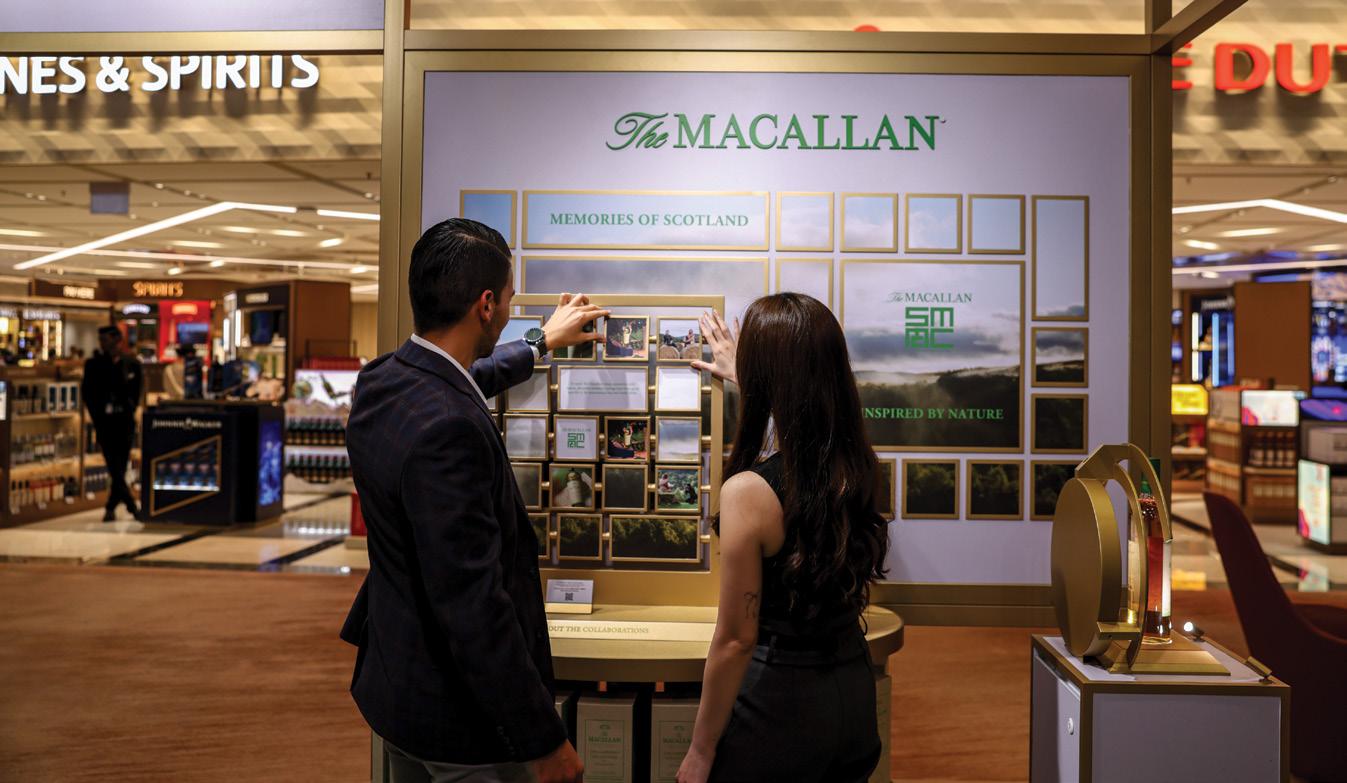
latest launch for The
phenomenal year for tequila in TR and it is really exciting to see the interest and excitement around rum, too,” she notes.
Edrington focuses on educational and sensory experiences to draw in consumers. “Shopper engagement is a really important facet of our proposition at the point of sale, particularly when it comes to education and recruitment,” says Spiers. The launch of The Macallan Colour Collection included interactive elements like “Discover Your Expression” profiling tools and QR code-driven stories at activation sites.
Brown-Forman has made a significant impact with its exclusive launch at one of Asia’s busiest hubs. Rodiek says, “We launched our GTR-exclusive innovation Jack Daniel’s American Single Malt with a spectacular pop-up at Changi Airport in Singapore. The sen-
sational Jack Daniel’s American Single Malt experience has showcased the craft and ‘richer sipping’ behind the whiskey innovation and forged a new path to enhance the perception of American single malt whiskey.”
Diageo has implemented a series of high-touch, luxurious activations across the region. “Last year and into this year we have put considerable effort and ingenuity into the launch of Johnnie Walker Blue Label Xordinaire,” says Tassilly. Engagement methods included tasting events, dinners, and innovative digital experiences that enhance the storytelling aspect of their brands.
Innovative marketing strategies involving influencers and Key Opinion Leaders (KOLs) enhance brand visibility and engagement. Campaigns utilize digital platforms and influencer partnerships
The introduction of exclusive products like Jack Daniel’s American Single Malt and limited editions such as Woodford Reserve Master’s Collection have been central to Brown-Forman’s strategy. The activation for Jack Daniel’s American Single Malt at Changi Airport reached approximately three million passengers
to reach and resonate with diverse consumer groups.
“By leveraging real-time data and insights, we worked closely to develop and refine our ad creatives for maximum effectiveness,” says Rodiek. This approach involved extensive testing and adaptation to ensure the creatives were culturally relevant and engaging, significantly boosting media performance and establishing a strong consumer connection.
Diageo’s recent campaign for JW BL Xordinaire, aimed to reach broader audiences, including those with sweeter palates. “This is where influencers –whether they are a journalist, a social media influencer, or an expert with their own credentials in taste and style is vital,” Tassilly states.
Recently, in response to the unique preferences of Asian consumers, Brown-Forman launched the Woodford Reserve Double XO. “This product features a blend of two distinct bourbons aged in American oak and ex-Cognac barrels, specifically designed to cater to the discerning tastes prevalent in the region,” says Rodiek. “In addition to our focus on liquid innovation, we have introduced region-specific secondary packaging designs, including a special edition for Woodford that was released around the time of Diwali.”
Tassilly says, “In APAC we know gifting – Diwali and Lunar New Year for example – so exclusives and LTOs, which link to a memorable occasion or demonstrate something special, are important.” Tassilly mentions recent innovations in Xordinaire as a great example. In India, Diageo has successfully introduced tequila as a luxury brand with the launch of Don Julio 1942, aligning the product with the grandeur of Indian celebrations.
Fraternity Spirits offers a unique journey through Mexican heritage; anchored by Hacienda Corralejo, it pioneers in sustainability and custom aging, redefining the premium spirits landscape
by WENDY MORLEY
In the premium spirits category, Fraternity Spirits stands out for its quality, innovation, and cultural heritage. With over two decades of experience, this respected company has skillfully navigated the intricate landscape of the global spirits market, establishing itself as a formidable player. At the heart of Fraternity Spirits’ success
is its unwavering commitment to excellence, a trait that resonates through its diverse portfolio of premium spirits.
Central to Fraternity Spirits’ narrative is the iconic Hacienda Corralejo, the birthplace of Tequila Corralejo, the flagship brand that embodies the rich Mexi-
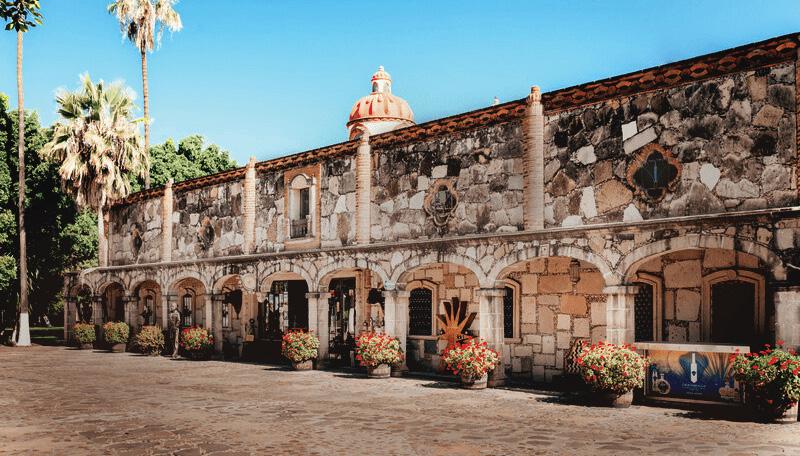
With a keen eye on emerging trends and consumer preferences,
can tradition of tequila making. Nestled in the historic region of Penjamo, Guanajuato, Hacienda Corralejo is not just a distillery; it is a living museum, a testament to the enduring legacy of Mexican craftsmanship. The hacienda stands as a monument to the centuries-old traditions of tequila production, intertwined with modern practices that push the boundaries of quality and flavor.
Innovation meets tradition
Fraternity Spirits is renowned for its innovative approach to production, seamlessly blending traditional methods with contemporary techniques. This fusion is exemplified in “99000 Horas” tequila, a product that represents the meticulous aging process that spans over 11 years, from agave cultivation to the final aging stage. This dedication to the craft ensures a tequila of unparalleled smoothness and complexity, a true
Fraternity Spirits is poised to introduce new products and enter untapped marketstestament to the brand’s commitment to excellence.
The company has also taken significant strides toward sustainability, particularly through its Blue Dream glass factory. Here, the company champions environmental stewardship by incorporating recycled glass into its bottles, showcasing a harmonious balance between quality spirit production and ecological responsibility.
Fraternity Spirits recognizes the unique opportunity travel retail offers to connect with a diverse clientele of international travelers. By offering a taste of Mexico’s rich cultural heritage through its premium offer, Fraternity Spirits not only caters to the discerning tastes of global consumers, but also serves as an ambassador of Mexican tradition and craftsmanship.
Its strategic presence in duty free shops and travel retail outlets around the globe has allowed Fraternity Spirits to cultivate a sense of exclusivity and allure around its brands. This approach has not only expanded the company’s market reach but has also elevated the consumer experience, transforming the
act of purchasing a bottle of tequila or mezcal into a cultural exploration.
From the smooth and sophisticated Tequila Corralejo to the bold and traditional Mezcal Espanta Espíritus, the company offers a diverse range of spirits that cater to a variety of palates. This diversity is a reflection of Fraternity Spirits’ deep understanding of the global consumer’s evolving preferences and its ability to adapt and innovate accordingly.
In light of the growing aged-spirit trend, Fraternity Spirits introduced an innovative concept that allows consumers to personalize the “aging” of their spirit to their own taste. This initiative, led by CEO Raffaele Berardi and Don Leonardo, founder of Tequila Corralejo and Ron Prohibido, offers a home-aging solution through the “Rompe las Barreras del Tiempo” kit. This kit includes Ron Prohibido, an American oak stick for extra toasting, a stylish glass decanter, and a cork stopper, enabling consumers to infuse and customize the flavor profile of their spirits conveniently at home, without the traditional investments associated with barrel aging, democratizing the
aging process and creating an engaging, shareable experience.
Looking ahead, Fraternity Spirits continues to set its sights on innovation and expansion. With a keen eye on emerging trends and consumer preferences, the company is poised to introduce new products and enter untapped markets. The commitment to sustainability and environmental stewardship remains a core principle, guiding future initiatives and ensuring that Fraternity Spirits not only leads in the present but paves the way for a sustainable future.
Through its dedication to crafting exceptional spirits, commitment to sustainability and strategic positioning in the global market, the company has solidified its standing as a leader in the premium spirits industry. As Fraternity Spirits continues to evolve and expand, it remains anchored by its heritage, driven by innovation, and inspired by the diverse tapestry of cultures it serves. In the world of Fraternity Spirits, every bottle tells a story — a story of passion, craftsmanship and the relentless pursuit of excellence.

Jägermeister sales surge in 2023, driving global growth amid challenges
by HIBAH NOOR
In the fiscal year 2023, family-owned German spirits manufacturer MastJägermeister SE reported an 8.1% increase in sales, reaching EUR 961.7 million (US$1031.57 million), excluding spirits tax. A key factor in this growth was the sale of 9.2 million 9-liter cases of Jägermeister, making it the secondmost-successful year in the company’s history, just slightly behind sales in 2022, which was an exceptional year following the pandemic.
Jägermeister, the flagship brand for the company, is distributed in over 150 countries, with exports accounting for over 80% of sales. Additionally, the company has seen significant success with its premium tequila brand, Teremana, in North America, where sales surged by 36% to 1.25 million 9-liter cases in 2023.
Over the past year, the spirits industry has faced challenges including political and economic instability, which affected consumer confidence and led to cautious purchasing behavior worldwide. Despite these challenges, Jägermeister managed to grow in some regions, particularly in Western and Eastern Europe and Asia, while
maintaining stable sales in the UK and Germany. The US market, however, experienced a downturn. The brand saw significant growth in China and continued its upward trajectory in global travel retail, with double-digit revenue growth.
Mast-Jägermeister SE has been investing in expanding its supply chain and production capacities, including a new bottling line for miniature bottles in Wolfenbüttel-Linden and a barrel storage facility in Kamenz, Saxony, designed to be CO2-neutral and house up to 225 oak barrels.
The company has also supported the nightlife community through initiatives like #SAVETHENIGHT, which included backing for the Emmy Award-winning “Lesbian Bar Project” in the US, among other international projects.
Teremana’s rapid growth in the US has led to plans for its introduction in duty free outlets at international airports and subsequent launches in Germany and other markets. A second distillery in Jalisco, Mexico, has been opened to
meet the increasing demand for this premium tequila. In the US, the brand launched its Mana Holiday House program, a comprehensive marketing activation.
Since acquiring the craft gin brand GIN SUL in 2018, Mast-Jägermeister has tripled production capacity to support its regional expansion and launched GIN SUL Laranjal, a new addition to its portfolio, in the German market.
Looking forward, CEO Michael Volke says, “We are cautiously optimistic about achieving a stable, high result with our core brand Jägermeister, even amidst the fragility of the consumer climate in many markets.”
Volke aims not only to sustain Teremana’s remarkably dynamic growth in the US market but also to export this success to other markets. He states, “We have accumulated significant expertise in internationalizing a premium spirit with Jägermeister. Now, we will leverage that knowledge to successfully introduce Teremana into new markets worldwide.”


Kavalan’s new Master’s Select Reserve malt whiskies embody the essence of the distillery, which has been leading the art of single malt whisky in Taiwan since 2005
by HIBAH NOORKavalan, the distillery which has been pioneering the art of single malt whisky in Taiwan since 2005, has launched two travel retailexclusive expressions.
Master's Select Reserve No. 1 combines ex-Bourbon barrels and lightly peated STR (scraped, toasted and recharred) casks while Master's Select Reserve No. 2 marries ex-Port barriques with lightly peated STR casks.
STR casks are treated using the Taiwanese distiller’s Shave-Toast-Rechar technique to unlock flavors hidden in the oak's deep layers.
Master’s Select Reserve No. 1 offers a harmony of fruity sweetness with a warm, gentle peaty and nutty essence while Master’s Select Reserve No. 2 has intense aromas of dark berries and stone fruits melded together. Both express the essence of Kavalan and highlight the exceptional craftsmanship and barrel selection of the distiller’s skilled blending team.
According to Kavalan, the double
launch in April of one-liter Master’s Select Reserve No. 1 and No. 2 (USD$110, 40%ABV) will take advantage of a rapidly recovering international travel world, “a post-COVID retail travel market that prioritizes quality over quantity”.
Zerose Yang, Kavalan Senior Blender, says, “We had such a great response to our Kavalan Artist Series, that we created the Master’s Select. Our STR technique improves the whisky's body, making our flavors more robust, rounded, and smooth. Master’s Select Reserve No. 1 ex-bourbon flavors and its lightly peaty character harmonize well with vanilla and buttery flavors. Master’s Select No. 2 combines the port berry aromas of the ex-Port casks with a hint of peat, enhancing the depth of the robust wine cask style.”
The whiskies will launch in South Korea, Singapore, India, Vietnam and Hong Kong this year, followed by other Asian airport duty free shops. The newly developed duty free shop at Bahrain
International Airport will also feature the new expressions.
Master’s Select Reserve No. 1 has a Golden Sunrise color. On the nose, a delicate peat aroma with a hint of saltiness perfectly complements the sweetness. On the palate, cream and vanilla lead, unveiling notes of caramelized crème brûlée a honey sweetness, followed by pineapple, apple, and lemon pound cake aromas to create a rich, full-bodied, and “refreshingly tantalizing” experience.
Master’s Select Reserve No. 2 has a Toasty Sunlight color. On the nose, gentle peaty and nutty notes, while the palate offers longan and red date tea, accompanied by nutty woody spiciness. Following closely are the rich fruity aromas of grapes, berries, cherries, plums, and red apples, akin to a luscious warmth and a sweet nectar.
The Master’s Select packaging echoes the Snow Mountain Range, paying tribute to the rich, lingering aromas of the single malt whisky.

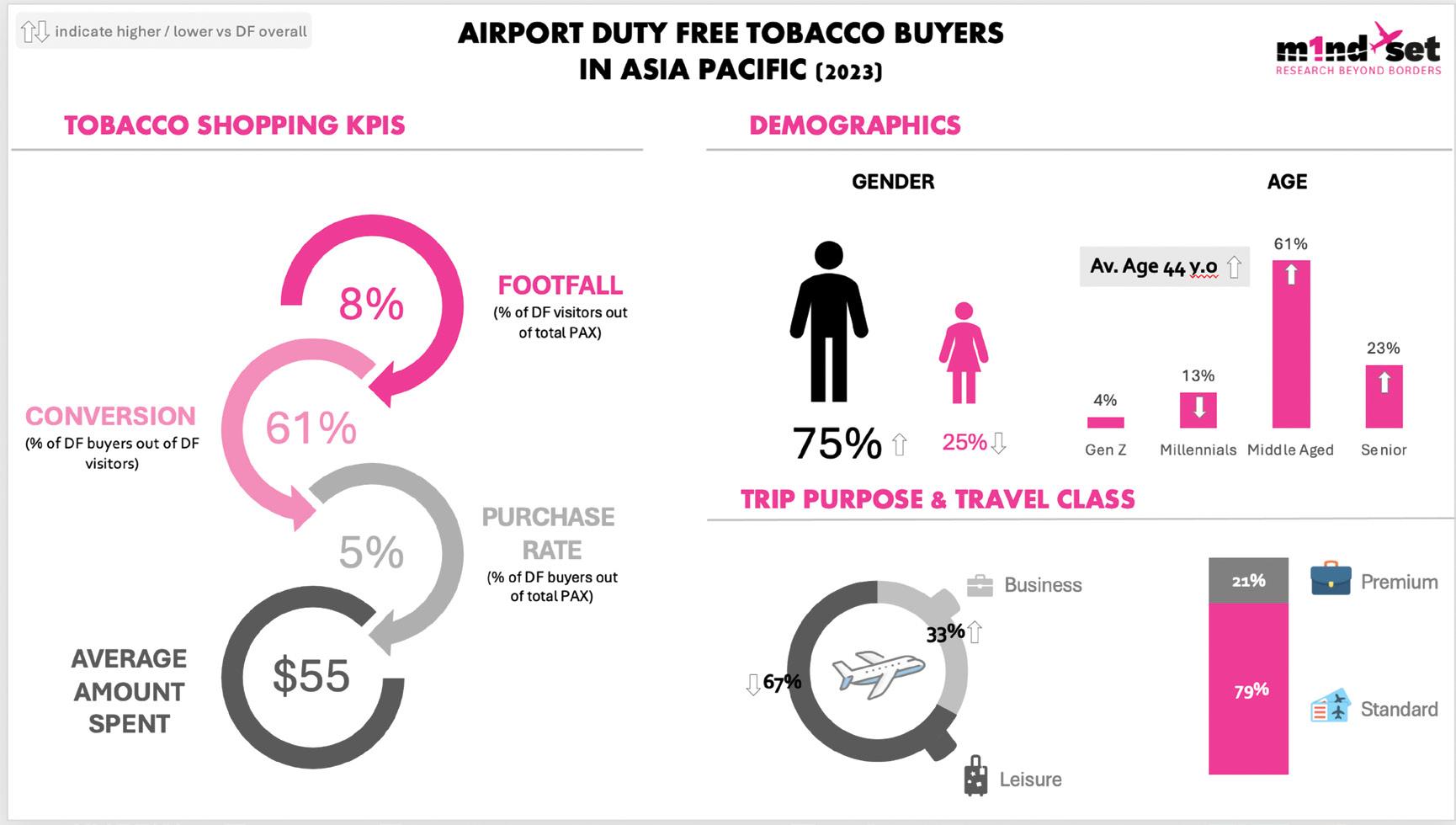
m1nd-set data from 2023 provides a clear indicator of the tobacco market in Asia Pacific; strong purchasing trends highlight an opportunity to capitalize on a niche but profitable segment
by LAURA SHIRK
Although only a small percentage of those who enter an Asia Pacific (APAC) duty free store go on to visit the tobacco department, those who do enter tend to purchase, according to a recent report by m1nd-set focusing on spirits and tobacco in the APAC region.
Overall, the m1nd-set data from 2023 provides a clear indicator of the strong yet niche market for tobacco in the Asia Pacific region, suggesting a targeted approach in marketing and customer engagement strategies could yield significant benefits for retailers operating in this space.
Tobacco continues to play a significant role in duty free, with a high conversion rate vs footfall. The report reveals that, while only 8% of travelers visit the
tobacco areas in these airports, the conversion rate is strikingly high, with over three out of five visitors (61%) making a purchase, leading to an average expenditure of US$55 per transaction.
Travelers who purchase tobacco products in APAC duty free are typically middle-aged men, predominantly traveling in standard class for leisure. This demographic profile contrasts with the overall duty free market, skewing older and decidedly male.
Tobacco purchases are mostly made for personal use, at 65%, with gifting a distant second at 15%, on request at 13%, and sharing at a mere 7%. In comparison to other duty free categories, the inclination to plan purchases ahead is strong among tobacco purchasers, with many planning right down to the brand
or SKU. This pre-planned purchasing behavior suggests a reduced impact of impulse buying, highlighting the need for engaging potential buyers before their travel.
Despite the planned nature of these purchases, m1nd-set’s research shows approximately half of tobacco buyers interact with sales staff, and of this number 59% report their buying decisions are influenced by these interactions. This highlights the crucial role of trained, knowledgeable sales staff in facilitating customer decisions, especially among the 35% of purchasers identified as “undecided planners.”
Price advantage and perceived value for money are the primary drivers of purchases in the duty free tobacco market, exceeding the duty free market overall. These factors outweigh even brand loyalty and personal indulgence, which continue to account for a significant proportion of the purchasing decisions. Given the propensity for self-purchases, the appeal of tobacco as a treat for customers in the particular demographic cannot be overestimated.






